Sunday, October 19, 2014
Bodie, California
Bodie, California
Birthplace of Ben Rosenthal, Residence of Davis Rosenthal Family 1870’s - 1881
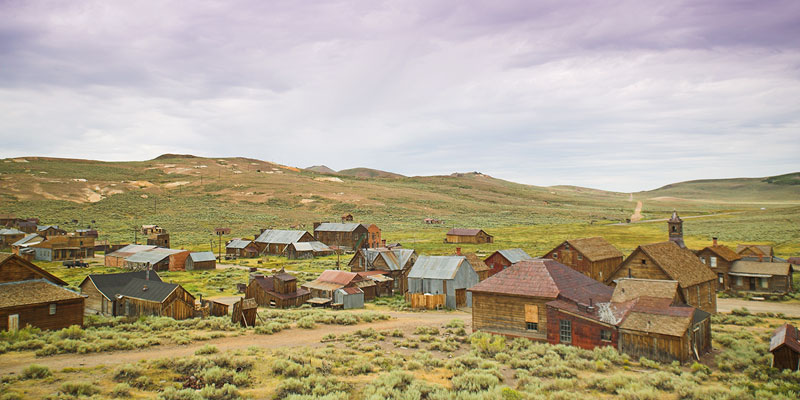 Bodie is located in the eastern slopes of the Sierra, close to the Nevada border. It can be righteously hot by midsummer and buried in snow in wintertime. In 1880 the town had nearly 8000 residents.
Bodie is located in the eastern slopes of the Sierra, close to the Nevada border. It can be righteously hot by midsummer and buried in snow in wintertime. In 1880 the town had nearly 8000 residents.
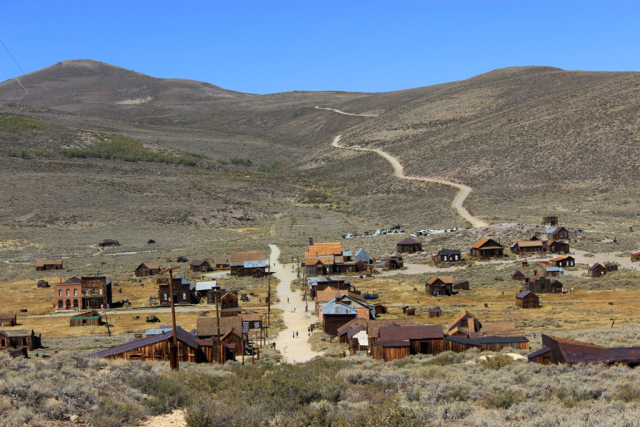

The 1849 discovery of gold at Sutter’s Mill in the western Sierra foothills lured men and women to California from across the United States and indeed the world. Prospectors equipped with picks, shovels, and the ubiquitous gold pans searched for placer deposits-loose flakes and nuggets that have eroded and washed into streams. These deposits were searched for by “panning” in which the lighter dirt is deftly washed out, leaving behind the flakes of “color” that are collectively called “gold dust.” The discovery of sufficient placer deposits sparked quests for the “mother lode,” involving hardrock mines laboriously dug, blasted, and shored up with timber (Williams 1992, 5; Smith 1925).
These deposits were searched for by “panning” in which the lighter dirt is deftly washed out, leaving behind the flakes of “color” that are collectively called “gold dust.” The discovery of sufficient placer deposits sparked quests for the “mother lode,” involving hardrock mines laboriously dug, blasted, and shored up with timber (Williams 1992, 5; Smith 1925).
 William S. Body found gold here in 1859. The mining camp grew slowly from 1860 to the mid-1870s, while its neighbor Aurora, Nevada, was booming.
Waterman S. Bodey (1814-1859)
William S. Body found gold here in 1859. The mining camp grew slowly from 1860 to the mid-1870s, while its neighbor Aurora, Nevada, was booming.
Waterman S. Bodey (1814-1859)
 Bodey was a prospector from Poughkeepsie, New York who discovered gold in Eastern California.Bodey's exact first name is uncertain. His name could be William, Waterman or Wakeman. In Poughkeepsie he owned his own business and was listed in the 1843 Poughkeepsie village directory. In the 1845 edition, he is listed as a tin manufacturer with his shop address of 345 Main Street. He is also listed in this same directory as having a home on the corner of South Hamilton and Montgomery streets.
Although Bodey was well respected within the community of Poughkeepsie, he desired a more adventurous life. In 1848, after receiving news of gold being discovered in California, Bodey said goodbye to his wife Sarah and his two children, and set sail for California and its gold on the Mathew Vasser. After rounding Cape Horn, Bodey landed in San Francisco in 1849.
In 1859, Bodey discovered gold in Eastern California, north of Mono Lake. This discovery sparked a gold rush: the town of Bodie, California sprang up around Bodey's discovery. Bodey did not profit from the discovery: he died in November 1859, after he decided to winter near his find with a Native American companion. He and his companion went out to make a supply trip to Monoville and got lost in a blizzard. When Bodey couldn't go any further, his companion left him and Bodey froze to death. Bodey's body was found the next spring.
Bodey was a prospector from Poughkeepsie, New York who discovered gold in Eastern California.Bodey's exact first name is uncertain. His name could be William, Waterman or Wakeman. In Poughkeepsie he owned his own business and was listed in the 1843 Poughkeepsie village directory. In the 1845 edition, he is listed as a tin manufacturer with his shop address of 345 Main Street. He is also listed in this same directory as having a home on the corner of South Hamilton and Montgomery streets.
Although Bodey was well respected within the community of Poughkeepsie, he desired a more adventurous life. In 1848, after receiving news of gold being discovered in California, Bodey said goodbye to his wife Sarah and his two children, and set sail for California and its gold on the Mathew Vasser. After rounding Cape Horn, Bodey landed in San Francisco in 1849.
In 1859, Bodey discovered gold in Eastern California, north of Mono Lake. This discovery sparked a gold rush: the town of Bodie, California sprang up around Bodey's discovery. Bodey did not profit from the discovery: he died in November 1859, after he decided to winter near his find with a Native American companion. He and his companion went out to make a supply trip to Monoville and got lost in a blizzard. When Bodey couldn't go any further, his companion left him and Bodey froze to death. Bodey's body was found the next spring.
“Black” Taylor, half-Cherokee
A decade after the gold rush began at Sutter’s Mill, four prospectors made a rich strike on the opposite side of the Sierras-that is, in the eastern foothills. They agreed to keep the discovery secret until the following spring, but one, W.S. Bodey, returned with another man, a half-Cherokee named “Black” Taylor. Having traveled to Monoville for supplies, the pair were returning to their cabin when they were caught in a blizzard and Bodey perished.
Named for its discoverer, camp Bodey was soon rechristened “Bodie” when (according to local lore) a sign painter misspelled the word and the new version was preferred. At first Bodie was largely neglected due to other strikes in the area. Mark Twain was among the gold seekers who rushed to nearby Aurora, Nevada, for instance.
Badman from Bodie
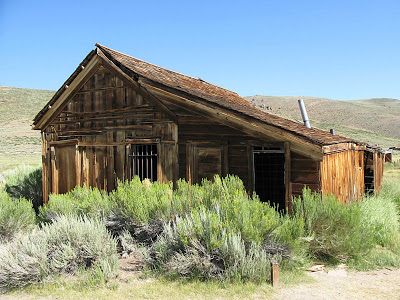 Bodie Town Jail
Bodie Town Jail
In 1859, prospectors chasing rumors of mineral wealth found gold east of the Sierra Nevada Mountains. Their discovery gave rise to Bodie, one of the West's wildest gold mining boomtowns. By 1880 the phrase "Badman from Bodie" described the town's rambunctious inhabitants, earning the community a reputation for violence that rivaled Tombstone, Deadwood and Dodge City.

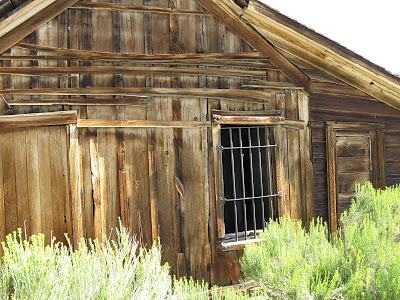
John Wayne was here in the early 1970's for a tv special. You can see him standing outside the jail. This is the barred window he was looking in.
Camps like Bodie attracted a breed of adventurous types:
Besides the business and professional men, mine-operators, miners, etc., there were hundreds of saloon-keepers, hundreds of gamblers, hundreds of prostitutes, many Chinese, a considerable number of Mexicans, and an unusual number of what we used to call “Bad men"-desperate, violent characters from everywhere, who lived by gambling, gun-fighting, stage robbing, and other questionable means. The “Bad man from Bodie” was a current phrase of the time throughout the west. In its day, Bodie was more widely known for its lawlessness than for its riches. (Smith 1925)
Given Bodie’s reputation, it is perhaps not surprising that one little girl, whose family was moving to the mining town, reportedly prayed: “Goodbye God! We are going to Bodie” (Smith 1925).
There were other perils and hardships, including the savage winter of 1878-1879 in which hundreds died of exposure and disease, and mining accidents that claimed victims by falling timber, the explosion of a powder magazine, and other means (Smith 1925; Bodie Cemetery n.d.).
Bodie, California
Birthplace of Ben Rosenthal, Residence of Davis Rosenthal Family 1870’s - 1881
Bodie is located in the eastern slopes of the Sierra, close to the Nevada border. It can be righteously hot by midsummer and buried in snow in wintertime. In 1880 the town had nearly 8000 residents.
The 1849 discovery of gold at Sutter’s Mill in the western Sierra foothills lured men and women to California from across the United States and indeed the world. Prospectors equipped with picks, shovels, and the ubiquitous gold pans searched for placer deposits-loose flakes and nuggets that have eroded and washed into streams.
These deposits were searched for by “panning” in which the lighter dirt is deftly washed out, leaving behind the flakes of “color” that are collectively called “gold dust.” The discovery of sufficient placer deposits sparked quests for the “mother lode,” involving hardrock mines laboriously dug, blasted, and shored up with timber (Williams 1992, 5; Smith 1925).
William S. Body found gold here in 1859. The mining camp grew slowly from 1860 to the mid-1870s, while its neighbor Aurora, Nevada, was booming.
Waterman S. Bodey (1814-1859)
Bodey was a prospector from Poughkeepsie, New York who discovered gold in Eastern California.Bodey's exact first name is uncertain. His name could be William, Waterman or Wakeman. In Poughkeepsie he owned his own business and was listed in the 1843 Poughkeepsie village directory. In the 1845 edition, he is listed as a tin manufacturer with his shop address of 345 Main Street. He is also listed in this same directory as having a home on the corner of South Hamilton and Montgomery streets.
Although Bodey was well respected within the community of Poughkeepsie, he desired a more adventurous life. In 1848, after receiving news of gold being discovered in California, Bodey said goodbye to his wife Sarah and his two children, and set sail for California and its gold on the Mathew Vasser. After rounding Cape Horn, Bodey landed in San Francisco in 1849.
In 1859, Bodey discovered gold in Eastern California, north of Mono Lake. This discovery sparked a gold rush: the town of Bodie, California sprang up around Bodey's discovery. Bodey did not profit from the discovery: he died in November 1859, after he decided to winter near his find with a Native American companion. He and his companion went out to make a supply trip to Monoville and got lost in a blizzard. When Bodey couldn't go any further, his companion left him and Bodey froze to death. Bodey's body was found the next spring.
“Black” Taylor, half-Cherokee
A decade after the gold rush began at Sutter’s Mill, four prospectors made a rich strike on the opposite side of the Sierras-that is, in the eastern foothills. They agreed to keep the discovery secret until the following spring, but one, W.S. Bodey, returned with another man, a half-Cherokee named “Black” Taylor. Having traveled to Monoville for supplies, the pair were returning to their cabin when they were caught in a blizzard and Bodey perished.
Named for its discoverer, camp Bodey was soon rechristened “Bodie” when (according to local lore) a sign painter misspelled the word and the new version was preferred. At first Bodie was largely neglected due to other strikes in the area. Mark Twain was among the gold seekers who rushed to nearby Aurora, Nevada, for instance.
Badman from Bodie
Bodie Town Jail
In 1859, prospectors chasing rumors of mineral wealth found gold east of the Sierra Nevada Mountains. Their discovery gave rise to Bodie, one of the West's wildest gold mining boomtowns. By 1880 the phrase "Badman from Bodie" described the town's rambunctious inhabitants, earning the community a reputation for violence that rivaled Tombstone, Deadwood and Dodge City.
John Wayne was here in the early 1970's for a tv special. You can see him standing outside the jail. This is the barred window he was looking in.
Camps like Bodie attracted a breed of adventurous types:
Besides the business and professional men, mine-operators, miners, etc., there were hundreds of saloon-keepers, hundreds of gamblers, hundreds of prostitutes, many Chinese, a considerable number of Mexicans, and an unusual number of what we used to call “Bad men"-desperate, violent characters from everywhere, who lived by gambling, gun-fighting, stage robbing, and other questionable means. The “Bad man from Bodie” was a current phrase of the time throughout the west. In its day, Bodie was more widely known for its lawlessness than for its riches. (Smith 1925)
Given Bodie’s reputation, it is perhaps not surprising that one little girl, whose family was moving to the mining town, reportedly prayed: “Goodbye God! We are going to Bodie” (Smith 1925).
There were other perils and hardships, including the savage winter of 1878-1879 in which hundreds died of exposure and disease, and mining accidents that claimed victims by falling timber, the explosion of a powder magazine, and other means (Smith 1925; Bodie Cemetery n.d.).
The 601 Vigilante Group

It's not clear how that meaning came to be, but the history of Bodie is sometimes difficult to "prove" and is more often "interpreted" rather than "reported". There were many papers in Bodie and "creative journalism" was sometimes practiced in order to sell papers. Sadly, most of those "records" have been lost to history.
It's not clear how that meaning came to be, but the history of Bodie is sometimes difficult to "prove" and is more often "interpreted" rather than "reported". There were many papers in Bodie and "creative journalism" was sometimes practiced in order to sell papers. Sadly, most of those "records" have been lost to history.
The 601 and Joseph DeRoche
It was reported that during a ball at the Miner's Union Hall on Saturday, January 15, 1881, Joseph DeRoche danced with the wife of Thomas Trelour, even though Trelour asked his wife not to. It's unknown if words were exchanged or if some other argument took place, but DeRoche left the event before most of the other attendees.
When Trelour and his wife left the Hall, they walked down Main Street. At the corner of Main & Lowe Streets, DeRoche jumped from the darkness and shot Treloar in the head. DeRoche was immediately arrested, but was handed over to Deputy Farnsworth, who was drunk at the time. DeRoche quickly escaped.
 DeRoche made a run for it down Goat Ranch Road, but was caught about eight miles away and returned to Bodie. He was hanged by the Bodie 601 vigilante group on Monday, January 24, 1881. Below is an article that was printed by The Bodie Free Press newspaper:
DeRoche made a run for it down Goat Ranch Road, but was caught about eight miles away and returned to Bodie. He was hanged by the Bodie 601 vigilante group on Monday, January 24, 1881. Below is an article that was printed by The Bodie Free Press newspaper:
Judge Lynch held his first court session in Bodie early on Monday morning and passed iudgment on a criminal whose crime is already recorded and impressed on every mind in this community. The tragic end of DeRoche, the murderer, was at once awful and impressive.
The lesson to be learned from it is easily read and the simplest mind can fully comprehend it. That a cruel murder had been committed no one can deny; that the swift retribution was expected every observing citizen could predict with safety. The excitement of the Sabbath did not die away and the wrath of the people did not go out with the setting of the sun. As the shades of darkness enveloped the town, the spirit of revenge increased in intensity and developed into a blazing column of fire. It was burning in its intensity and fearful in its results.
After the adiournment of the court and DeRoche was token back to his narrow cell, a mysterious committee was organized, the like of which has existed in many towns on this Coast since '46, and whose work has been quick and thorough. The Committee, it is reported, held a long session and discussed the matter in hand. The session was long and deliberate, and its conclusions resulted in the lynching of DeRoche.
Between 1:30 and 2 o'clock Monday morning, a long line of masked and unmasked men were seen to file out of a side street into Bonanza Avenue. There must have been two hundred of them and as the march progressed to the jail the column increased. In front were the shotguns carried by determined men. They were backed up by a company which evidently meant business, and no ordinary force could foil them in their progress.
When the jail was reached it was surrounded and the leader made a loud knock at the door. All was dark and quiet within. The call had the effect of producing a dim light in the office, and amid loud cries of "DeRoche," "Bring him out," "Open the door," "Hurry up," etc. Jailer Kirgan appeared, and responded by saying: "All right boys; wait a minute; give me a little time." In a moment the outside door was opened slowly and four or five men entered. Under instructions the door of the cell in which the condemned prisoner lay was swung open. The poor wretch knew what this untimely visit meant, and prepared for the trying and humiliating death. It was some moments before he was brought out, and the crowd began to grow impatient. Some imagined the prisoner had been taken away by the officers - If this had been the case what would have followed can only be imagined. All these doubts were put at rest by the presence of the man.
He wore light-colored pants, a colored calico shirt, and over his shoulders was hung a canvas coat buttoned around the neck. His head was bare, and as the bright rays of the moon glanced upon his face, there was a picture of horror visible. It was a look of dogged and defiant submission. With a firm step he descended the steps and came out upon the street in a hurried manner, closely guarded by shotguns and revolvers. The order to fall in was given, and all persons not members of the mysterious committee to stand back.
 The march up Bonanza Street was rapid. Not a word was said by the condemned man, and his gaze was fixed upon the ground. He was hurried up a back street to Fuller. The corner of Green was turned, and when Webber's blacksmith shop was reached, a halt was made. In front of this place was a huge gallows frame, used for raising wagons, etc., while being repaired. Now it was to be used for quite a different purpose. "Move it over to the spot where the murder was committed," was the order, and immediately it was picked up by a dozen men and was carried to the corner of Main and Lowe streets. The condemned man glanced at it for a moment and an apparent shudder came over him, but he uttered not a word. From an eye witness we learn that the scene which followed was awful in its impressiveness. The snow had iust begun to fall, and the moon, which had shone so brightly during the early part of the night, shed but a pale light on the assembled company. When the corner was reached, the heavy gallows frame was placed upon the ground, and the prisoner led under it. The prisoner's demeanor still remained passive, and his hands, encased in irons, were clasped.
The march up Bonanza Street was rapid. Not a word was said by the condemned man, and his gaze was fixed upon the ground. He was hurried up a back street to Fuller. The corner of Green was turned, and when Webber's blacksmith shop was reached, a halt was made. In front of this place was a huge gallows frame, used for raising wagons, etc., while being repaired. Now it was to be used for quite a different purpose. "Move it over to the spot where the murder was committed," was the order, and immediately it was picked up by a dozen men and was carried to the corner of Main and Lowe streets. The condemned man glanced at it for a moment and an apparent shudder came over him, but he uttered not a word. From an eye witness we learn that the scene which followed was awful in its impressiveness. The snow had iust begun to fall, and the moon, which had shone so brightly during the early part of the night, shed but a pale light on the assembled company. When the corner was reached, the heavy gallows frame was placed upon the ground, and the prisoner led under it. The prisoner's demeanor still remained passive, and his hands, encased in irons, were clasped.

"Pull him," was the order, and in a twinkling the body rose three feet from the ground. Previous to putting on the rope, the overcoat was removed.
A second after the body was elevated a sudden twitch of the legs was observed, but with that exception, not a muscle moved while the body hung on the crossbeam. His death took place without a particle of pain. The face was placid, and the eyes closed and never were reopened.
Strangulation must have been immediate. While the body swung to and fro, like a pendulum of a clock, the crowd remained perfectly quiet. After a lapse of two or three minutes a voice, sharp and clear, was heard in the background: "I will give $100 if twenty men connected with this affair will publish their names in the paper tomorrow morning." The voice was immediately recognized as that of a leading attorney. (Only Pat Reddy would have had the courage to face the mob, and a yell went up from the crowd.) "Give him the rope," "Put him out," and similar sentences drowned out the man and his voice. His retreat was as dignified as the exigencies of the case would admit of. While the body was still hanging a paper was pinned onto his breast bearing the following inscription: "All others take warning. Let no one cut him down. Bodie 601."
The Standard Mill
 The Standard Mill,1879
The Standard Mill,1879
It was reported that during a ball at the Miner's Union Hall on Saturday, January 15, 1881, Joseph DeRoche danced with the wife of Thomas Trelour, even though Trelour asked his wife not to. It's unknown if words were exchanged or if some other argument took place, but DeRoche left the event before most of the other attendees.
When Trelour and his wife left the Hall, they walked down Main Street. At the corner of Main & Lowe Streets, DeRoche jumped from the darkness and shot Treloar in the head. DeRoche was immediately arrested, but was handed over to Deputy Farnsworth, who was drunk at the time. DeRoche quickly escaped.
Judge Lynch held his first court session in Bodie early on Monday morning and passed iudgment on a criminal whose crime is already recorded and impressed on every mind in this community. The tragic end of DeRoche, the murderer, was at once awful and impressive.
The lesson to be learned from it is easily read and the simplest mind can fully comprehend it. That a cruel murder had been committed no one can deny; that the swift retribution was expected every observing citizen could predict with safety. The excitement of the Sabbath did not die away and the wrath of the people did not go out with the setting of the sun. As the shades of darkness enveloped the town, the spirit of revenge increased in intensity and developed into a blazing column of fire. It was burning in its intensity and fearful in its results.
After the adiournment of the court and DeRoche was token back to his narrow cell, a mysterious committee was organized, the like of which has existed in many towns on this Coast since '46, and whose work has been quick and thorough. The Committee, it is reported, held a long session and discussed the matter in hand. The session was long and deliberate, and its conclusions resulted in the lynching of DeRoche.
Between 1:30 and 2 o'clock Monday morning, a long line of masked and unmasked men were seen to file out of a side street into Bonanza Avenue. There must have been two hundred of them and as the march progressed to the jail the column increased. In front were the shotguns carried by determined men. They were backed up by a company which evidently meant business, and no ordinary force could foil them in their progress.
When the jail was reached it was surrounded and the leader made a loud knock at the door. All was dark and quiet within. The call had the effect of producing a dim light in the office, and amid loud cries of "DeRoche," "Bring him out," "Open the door," "Hurry up," etc. Jailer Kirgan appeared, and responded by saying: "All right boys; wait a minute; give me a little time." In a moment the outside door was opened slowly and four or five men entered. Under instructions the door of the cell in which the condemned prisoner lay was swung open. The poor wretch knew what this untimely visit meant, and prepared for the trying and humiliating death. It was some moments before he was brought out, and the crowd began to grow impatient. Some imagined the prisoner had been taken away by the officers - If this had been the case what would have followed can only be imagined. All these doubts were put at rest by the presence of the man.
He wore light-colored pants, a colored calico shirt, and over his shoulders was hung a canvas coat buttoned around the neck. His head was bare, and as the bright rays of the moon glanced upon his face, there was a picture of horror visible. It was a look of dogged and defiant submission. With a firm step he descended the steps and came out upon the street in a hurried manner, closely guarded by shotguns and revolvers. The order to fall in was given, and all persons not members of the mysterious committee to stand back.
The march up Bonanza Street was rapid. Not a word was said by the condemned man, and his gaze was fixed upon the ground. He was hurried up a back street to Fuller. The corner of Green was turned, and when Webber's blacksmith shop was reached, a halt was made. In front of this place was a huge gallows frame, used for raising wagons, etc., while being repaired. Now it was to be used for quite a different purpose. "Move it over to the spot where the murder was committed," was the order, and immediately it was picked up by a dozen men and was carried to the corner of Main and Lowe streets. The condemned man glanced at it for a moment and an apparent shudder came over him, but he uttered not a word. From an eye witness we learn that the scene which followed was awful in its impressiveness. The snow had iust begun to fall, and the moon, which had shone so brightly during the early part of the night, shed but a pale light on the assembled company. When the corner was reached, the heavy gallows frame was placed upon the ground, and the prisoner led under it. The prisoner's demeanor still remained passive, and his hands, encased in irons, were clasped.
"Pull him," was the order, and in a twinkling the body rose three feet from the ground. Previous to putting on the rope, the overcoat was removed.
A second after the body was elevated a sudden twitch of the legs was observed, but with that exception, not a muscle moved while the body hung on the crossbeam. His death took place without a particle of pain. The face was placid, and the eyes closed and never were reopened.
Strangulation must have been immediate. While the body swung to and fro, like a pendulum of a clock, the crowd remained perfectly quiet. After a lapse of two or three minutes a voice, sharp and clear, was heard in the background: "I will give $100 if twenty men connected with this affair will publish their names in the paper tomorrow morning." The voice was immediately recognized as that of a leading attorney. (Only Pat Reddy would have had the courage to face the mob, and a yell went up from the crowd.) "Give him the rope," "Put him out," and similar sentences drowned out the man and his voice. His retreat was as dignified as the exigencies of the case would admit of. While the body was still hanging a paper was pinned onto his breast bearing the following inscription: "All others take warning. Let no one cut him down. Bodie 601." The Standard Mill
The Standard Mill,1879
Discovery of the Standard Mine
 Note: The following is excerpted from "The Story of Mono County" by Ella M. Cain who was born in Bodie and later taught school there. She was married to David Cain, the son of James S. Cain who was one of Bodie’s early settlers and later one of the principal land owners (his house is the one with the green house window at the corner of Green and Park streets).
Note: The following is excerpted from "The Story of Mono County" by Ella M. Cain who was born in Bodie and later taught school there. She was married to David Cain, the son of James S. Cain who was one of Bodie’s early settlers and later one of the principal land owners (his house is the one with the green house window at the corner of Green and Park streets).
The Standard Mine, which eventually produced mullions, had a hard and varied career before it began to poor out the yellow metal to such an extent that one of the biggest gold rushes started that the West has ever known. The Standard was located under the name of The Bunker Hill Mine, the original locators selling out their interests for twenty thousand dollars to an actor named James Stark and a jeweler named John W. Tucker.
Stark owned an opera house in San Jose, and had the idea he could use it in his new venture in Bodie. But the job of transporting it to the latter place, and transforming acoustics built for Patti into frame work for a quartz mill was a sad experience for actor Stark and jeweler Tucker. They ran out of money and were forced to sell their "Opera House Mill" as it was called.
A geologist Professor J.D. Whitney gave a good report on the property, and new capital was brought in. A new consolidation of claims took place. Leland Stanford, then Governor of California, was elected President, and Judge F. T. Bechtel, Secretary. The new company was called "The Bodie Bluff Consolidated Mining Company", and was incorporated for over a million dollars.
Governor Stanford brought a mining expert up with him to Bodie. The "expert", in looking over the property advised Stanford to get out, saying he himself would not give five hundred dollars for the whole district. (The fact was that there were millions just beneath the place where they were then standing).
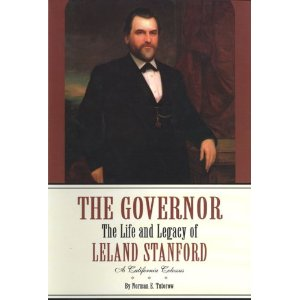
The Governor took his advice and decided to abandon this seemingly worthless mining ground. The so-called "expert" lived to regret the day he gave this advice.
This put a crimp in the camp for a time. The property then passed into the hands of four men who were without money, but who had faith and brawn. Their names were Essington, Lockberg, Mooney, and Walker. The two latter soon dropped out and the Swedes Essington and Lockberg went in together.
They were boarding with a man named William O’Hara, an Irishman by name and African by birth who grub-staked them. After they owed O’Hara nine hundred and fifty dollars they offered to give him the claim for what they owed. This was agreeable to O’Hara and the miners left. In vain, O’Hara offered the claim to any one who would pay him his nine hundred and fifty dollars. He had no takers.
Essington and Lockberg drifted around for some time and not finding anything as promising as Bodie they came back. O’Hara was willing to let them try again "on tick" and they again began digging and hoping. Lady Luck this time decided to smile on them from a dark cave in the earth.
Timber was scarce, so they used hardly enough for self protection. One day there was a rumble and roar, their tunnel had caved. Disheartened, they went to see the extent of the damages and there it was, the ledge they had dreamed of, had worked for, and had hoped to find.
It wasn’t long before they had cleaned up $37,000 from their "Aladdins Cave" in the gulch. They were using an arasttra and did not want to risk building a mill with this money. When four San Francisco capitalists, Seth Cook, Dan Cook, John Boyd, and William Lent, offered them $67,500 in cash for the claim, they sold.
The new owners erected a twenty stamp mill on th property and changed the name of the claim now known as Bunker Hill to The Standard Consolidated Company. These new owners took out the enormous sum of $6,396,270. The total production of all mining done in Bodie is estimated to be between 95 and 100 million.
Source:Cain, Ella M.,The Story of Bodie, Fearon Publishers, 1956.


Ore cart Small wrench

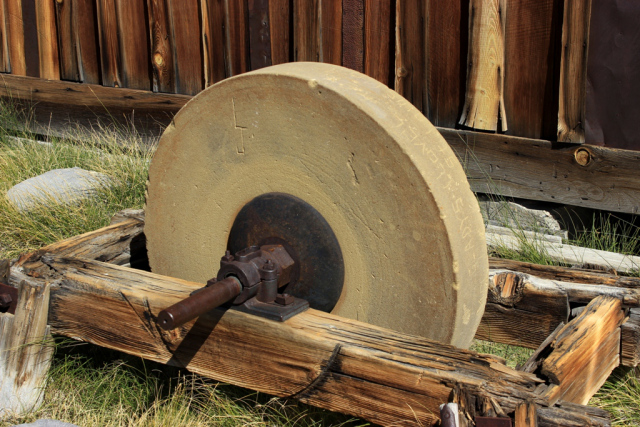

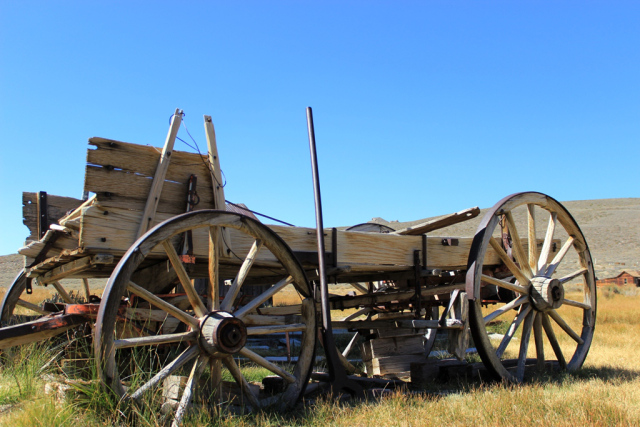
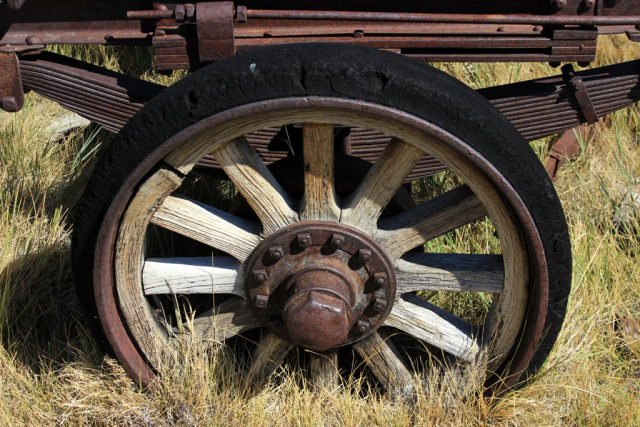

Note: The following is excerpted from "The Story of Mono County" by Ella M. Cain who was born in Bodie and later taught school there. She was married to David Cain, the son of James S. Cain who was one of Bodie’s early settlers and later one of the principal land owners (his house is the one with the green house window at the corner of Green and Park streets).
The Standard Mine, which eventually produced mullions, had a hard and varied career before it began to poor out the yellow metal to such an extent that one of the biggest gold rushes started that the West has ever known. The Standard was located under the name of The Bunker Hill Mine, the original locators selling out their interests for twenty thousand dollars to an actor named James Stark and a jeweler named John W. Tucker.
Stark owned an opera house in San Jose, and had the idea he could use it in his new venture in Bodie. But the job of transporting it to the latter place, and transforming acoustics built for Patti into frame work for a quartz mill was a sad experience for actor Stark and jeweler Tucker. They ran out of money and were forced to sell their "Opera House Mill" as it was called.
A geologist Professor J.D. Whitney gave a good report on the property, and new capital was brought in. A new consolidation of claims took place. Leland Stanford, then Governor of California, was elected President, and Judge F. T. Bechtel, Secretary. The new company was called "The Bodie Bluff Consolidated Mining Company", and was incorporated for over a million dollars.
Governor Stanford brought a mining expert up with him to Bodie. The "expert", in looking over the property advised Stanford to get out, saying he himself would not give five hundred dollars for the whole district. (The fact was that there were millions just beneath the place where they were then standing).
The Governor took his advice and decided to abandon this seemingly worthless mining ground. The so-called "expert" lived to regret the day he gave this advice.
This put a crimp in the camp for a time. The property then passed into the hands of four men who were without money, but who had faith and brawn. Their names were Essington, Lockberg, Mooney, and Walker. The two latter soon dropped out and the Swedes Essington and Lockberg went in together.
They were boarding with a man named William O’Hara, an Irishman by name and African by birth who grub-staked them. After they owed O’Hara nine hundred and fifty dollars they offered to give him the claim for what they owed. This was agreeable to O’Hara and the miners left. In vain, O’Hara offered the claim to any one who would pay him his nine hundred and fifty dollars. He had no takers.
Essington and Lockberg drifted around for some time and not finding anything as promising as Bodie they came back. O’Hara was willing to let them try again "on tick" and they again began digging and hoping. Lady Luck this time decided to smile on them from a dark cave in the earth.
Timber was scarce, so they used hardly enough for self protection. One day there was a rumble and roar, their tunnel had caved. Disheartened, they went to see the extent of the damages and there it was, the ledge they had dreamed of, had worked for, and had hoped to find.
It wasn’t long before they had cleaned up $37,000 from their "Aladdins Cave" in the gulch. They were using an arasttra and did not want to risk building a mill with this money. When four San Francisco capitalists, Seth Cook, Dan Cook, John Boyd, and William Lent, offered them $67,500 in cash for the claim, they sold.
The new owners erected a twenty stamp mill on th property and changed the name of the claim now known as Bunker Hill to The Standard Consolidated Company. These new owners took out the enormous sum of $6,396,270. The total production of all mining done in Bodie is estimated to be between 95 and 100 million.
Source:Cain, Ella M.,The Story of Bodie, Fearon Publishers, 1956.
Ore cart Small wrench
The cyanide leaching process
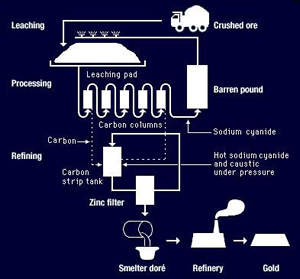
In the early days of mining, men would extract gold by placer mining, or by panning. Eventually the larger pieces were played out, and a new process was needed to collect the tiny fragments that were embedded into hard rock.
One process was the stamp mill. Large, heavy stamps were used to crush large rock into fine rock, then that fine rock could be sifted much like miners did it by hand when panning. However, not all of the gold and silver was extracted this way either. Once the fine rock went through this method, the gold and silver was usually so small, it wasn't cost effective to try to extract it. The remainder was dumped into large piles (these piles were called 'tailings') and left as a by-product of mining.
Then the "cyanide leaching process" was developed. Mixing the tailings with a cyanide solution, or simply spraying the tailings with a cyanide solution, would cause a chemical reaction to take place. When gold and silver comes in contact with cyanide, it liquefies. Now the gold-silver-cyanide solution can be drained off and processed again - but this time without the fine rock.
Another chemical reaction is put to work to separate the cyanide solution from the liquid gold and silver. Zinc is then mixed with this solution, which causes the gold and silver to return to a solid form.
Now there is a solid of gold, silver, and zinc. Yet another chemical reaction is used to remove the zinc. Sulphuric acid dissolves the zinc and leaves just the gold-silver mixture.
This gold-silver solid can then be melted down into bar for later processing to separate the gold from the silver.

Miners Union Hall
 Main Street 1880 (detail) looking south toward Bodie Foundry,
(Courtesy Mono County Historical Society)
Main Street 1880 (detail) looking south toward Bodie Foundry,
(Courtesy Mono County Historical Society)
 Main Street 1880 (detail) looking
south from Standard Ave.,
(Courtesy Mono County Historical Society)
Main Street 1880 (detail) looking
south from Standard Ave.,
(Courtesy Mono County Historical Society)
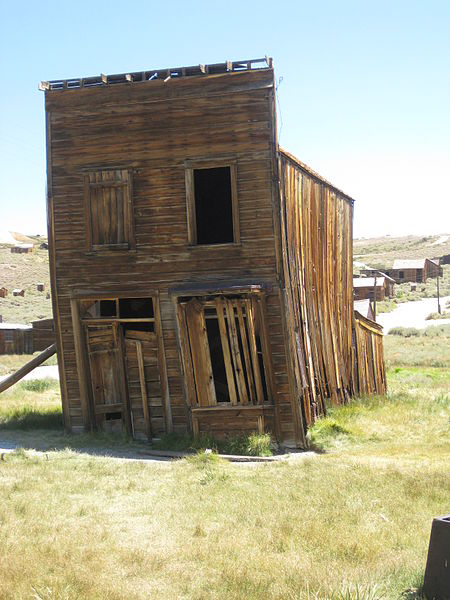
People of Brodie
Madame Moustache
Madame Moustache was the pseudonym of Eleanor Dumont (also called Eleonore Alphonsine Dumant) (1834, France - 1879,Bodie, CA) a notorious gambler on the American Western Frontier, especially during the California Gold Rush. Her nickname was due to the appearance of a line of dark hair on her upper lip.
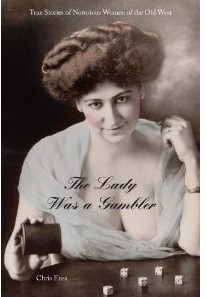
She was thought to have been born in France and moved to America as a young woman.
She was an accomplished card dealer and made a living from twenty-one and other casinogames. Moving from place to place, she was reported to work in Bodie, California; Deadwood, South Dakota; Fort Benton, Montana; Pioche, Nevada; Tombstone, Arizona; and San Francisco, California, among other places.
In Nevada City, California, she opened up the gambling parlor named "Vingt-et-un" on Broad Street. Only well-kept men were allowed in, and no women save herself. All the men admired her for her beauty and charm, but she kept them all a nice distance away. She was a very private lady, so she flirted, but only to keep the boys coming. Men came from all around to see the woman dealer - this was rare then - and considered it a privilege. The parlor found much success, so she decided to go into business with Dave Tobin, an experienced gambler. They opened up Dumont's Place, which was very successful until the gold started to dry up in Nevada City. She left Tobin and Nevada City for brighter things.
There was a brief period in Carson City where she bought a ranch and some animals. It was there that she fell in love with Jack McKnight, who conned her out of all of her money.
She moved around from city to city, gambling and building up her money again. Her age started to increase, and with that a lot of the beauty that once entranced miners, faded. This is when the famous mustache began to grow. She still drew crowd though, and had a long-standing reputation for dealing fair. She also added prostitution to her repertoire during these later years - she became a "madame" of a brothel in the 1860s. To promote her business, she would parade her girls around the town in carriages, showing off their beauty in broad daylight, much to the gasping of the 'proper' women.
Her last stop was Bodie, California. One night while gambling, she misjudged a play and suddenly owed a lot of money. That night she wandered outside of town and was found dead on September 8, 1879, of an overdose of morphine, apparently a suicide.
She also added prostitution to her repertoire during these later years - she became a "madame" of a brothel in the 1860s. To promote her business, she would parade her girls around the town in carriages, showing off their beauty in broad daylight, much to the gasping of the 'proper' women.
Her last stop was Bodie, California. One night while gambling, she misjudged a play and suddenly owed a lot of money. That night she wandered outside of town and was found dead on September 8, 1879, of an overdose of morphine, apparently a suicide.
In the early days of mining, men would extract gold by placer mining, or by panning. Eventually the larger pieces were played out, and a new process was needed to collect the tiny fragments that were embedded into hard rock.
One process was the stamp mill. Large, heavy stamps were used to crush large rock into fine rock, then that fine rock could be sifted much like miners did it by hand when panning. However, not all of the gold and silver was extracted this way either. Once the fine rock went through this method, the gold and silver was usually so small, it wasn't cost effective to try to extract it. The remainder was dumped into large piles (these piles were called 'tailings') and left as a by-product of mining.
Then the "cyanide leaching process" was developed. Mixing the tailings with a cyanide solution, or simply spraying the tailings with a cyanide solution, would cause a chemical reaction to take place. When gold and silver comes in contact with cyanide, it liquefies. Now the gold-silver-cyanide solution can be drained off and processed again - but this time without the fine rock.
Another chemical reaction is put to work to separate the cyanide solution from the liquid gold and silver. Zinc is then mixed with this solution, which causes the gold and silver to return to a solid form.
Now there is a solid of gold, silver, and zinc. Yet another chemical reaction is used to remove the zinc. Sulphuric acid dissolves the zinc and leaves just the gold-silver mixture.
This gold-silver solid can then be melted down into bar for later processing to separate the gold from the silver.
Miners Union Hall
Main Street 1880 (detail) looking south toward Bodie Foundry,
(Courtesy Mono County Historical Society)
Main Street 1880 (detail) looking
south from Standard Ave.,
(Courtesy Mono County Historical Society)
People of Brodie
Madame Moustache
Madame Moustache was the pseudonym of Eleanor Dumont (also called Eleonore Alphonsine Dumant) (1834, France - 1879,Bodie, CA) a notorious gambler on the American Western Frontier, especially during the California Gold Rush. Her nickname was due to the appearance of a line of dark hair on her upper lip.
She was thought to have been born in France and moved to America as a young woman.
She was an accomplished card dealer and made a living from twenty-one and other casinogames. Moving from place to place, she was reported to work in Bodie, California; Deadwood, South Dakota; Fort Benton, Montana; Pioche, Nevada; Tombstone, Arizona; and San Francisco, California, among other places.
In Nevada City, California, she opened up the gambling parlor named "Vingt-et-un" on Broad Street. Only well-kept men were allowed in, and no women save herself. All the men admired her for her beauty and charm, but she kept them all a nice distance away. She was a very private lady, so she flirted, but only to keep the boys coming. Men came from all around to see the woman dealer - this was rare then - and considered it a privilege. The parlor found much success, so she decided to go into business with Dave Tobin, an experienced gambler. They opened up Dumont's Place, which was very successful until the gold started to dry up in Nevada City. She left Tobin and Nevada City for brighter things.
There was a brief period in Carson City where she bought a ranch and some animals. It was there that she fell in love with Jack McKnight, who conned her out of all of her money.
She moved around from city to city, gambling and building up her money again. Her age started to increase, and with that a lot of the beauty that once entranced miners, faded. This is when the famous mustache began to grow. She still drew crowd though, and had a long-standing reputation for dealing fair.
She also added prostitution to her repertoire during these later years - she became a "madame" of a brothel in the 1860s. To promote her business, she would parade her girls around the town in carriages, showing off their beauty in broad daylight, much to the gasping of the 'proper' women.
Her last stop was Bodie, California. One night while gambling, she misjudged a play and suddenly owed a lot of money. That night she wandered outside of town and was found dead on September 8, 1879, of an overdose of morphine, apparently a suicide.
Rosa May Oalaque

Rosa May. Here she was about 24
Rosa May. Here she was about 24
Early life
Rosa's parents were Irish immigrants. In 1871 she ran away from her home in Pennsylvania and from 1871 to 1873, she began her career of prostitution. It appears that she began her trade in New York City, and then drifted through Colorado and Idaho. She first appears in Virginia City in 1873 and worked in brothels throughout the Carson City, Reno, Virginia City area.
Rosa's parents were Irish immigrants. In 1871 she ran away from her home in Pennsylvania and from 1871 to 1873, she began her career of prostitution. It appears that she began her trade in New York City, and then drifted through Colorado and Idaho. She first appears in Virginia City in 1873 and worked in brothels throughout the Carson City, Reno, Virginia City area.
Virginia City years
From 1873 to 1888, Rosa circulated in Virginia City and Carson City. The majority of her time was spent in Virginia City where she worked for Virginia City madam, Cad Thompson, (Sarah Higgins). Rosa was a favored “employee” and often was left in charge of the brothel during Cad’s trips to San Francisco.

Rosa May, "Spanish Madame", was buried outside of the cemetery proper. As she was a prostitute, some of the "upper-class" people in town would not approve of her getting a burial among the more "respectable" folks. It is said that she cared for the sick and ended up dying of pneumonia in the winter of 1912.
This headstone was placed here around 1965 by Louis Serventi. Louis's Uncle, Antonio, aparently lived near Rosa May when she was in Bodie. Uncle Antonio shared stories of Bodie with the children of his family. Many years later, after Louis had read Ella Cain's book The Story of Bodie, he went to Bodie and erected the marker.
However, this marker appears to be in the wrong location. There is/was a wooden fence around another spot near this marker, that is, or may have been, Rosa May's grave.
 Rosa May was the town's most famous prostitute. Born in Pennsylvania, she ran away at age 16 and drifted west, where she worked as a prostitute in mining camps to survive. She moved to Bodie in 1890, where in 1911 she died after caring for sick miners during a pneumonia outbreak. (Yep, a hooker with a heart of gold.)
Rosa May was the town's most famous prostitute. Born in Pennsylvania, she ran away at age 16 and drifted west, where she worked as a prostitute in mining camps to survive. She moved to Bodie in 1890, where in 1911 she died after caring for sick miners during a pneumonia outbreak. (Yep, a hooker with a heart of gold.)
They might not have been able to save Rosa May, but they did save her red light, which hangs in the town's small museum.
From 1873 to 1888, Rosa circulated in Virginia City and Carson City. The majority of her time was spent in Virginia City where she worked for Virginia City madam, Cad Thompson, (Sarah Higgins). Rosa was a favored “employee” and often was left in charge of the brothel during Cad’s trips to San Francisco.
Rosa May, "Spanish Madame", was buried outside of the cemetery proper. As she was a prostitute, some of the "upper-class" people in town would not approve of her getting a burial among the more "respectable" folks. It is said that she cared for the sick and ended up dying of pneumonia in the winter of 1912.
This headstone was placed here around 1965 by Louis Serventi. Louis's Uncle, Antonio, aparently lived near Rosa May when she was in Bodie. Uncle Antonio shared stories of Bodie with the children of his family. Many years later, after Louis had read Ella Cain's book The Story of Bodie, he went to Bodie and erected the marker.
However, this marker appears to be in the wrong location. There is/was a wooden fence around another spot near this marker, that is, or may have been, Rosa May's grave.
Rosa May was the town's most famous prostitute. Born in Pennsylvania, she ran away at age 16 and drifted west, where she worked as a prostitute in mining camps to survive. She moved to Bodie in 1890, where in 1911 she died after caring for sick miners during a pneumonia outbreak. (Yep, a hooker with a heart of gold.)
They might not have been able to save Rosa May, but they did save her red light, which hangs in the town's small museum.
Bodie years
From 1888 to the early 1890s, she traveled to and from Bodie, California and eventually settled there in 1893. She appears on the 1900 census records.Land records from 1902 show that Rosa purchased a house in Bodie’s “Red Light District” for $175.
There are no records of Rosa May living in Bodie after the 1910 census. The only evidence that she is buried in Bodie is a photo illustrating the Rosa May piece from Ella Cain's 1956 book, The Story of Bodie. This photo shows a decrepit wooden fence surrounding an otherwise unmarked grave. Since Ella Cain's biographical sketch of Rosa May is mostly fiction, it is likely the photo was chosen for its picturesque qualities. Author George Williams III conducted an exhaustive search in the 1970s for Rosa May's death records and found nothing
Bodie was declining rapidly during the period that Rosa May disappears, and it may be that she left the area in search of greener pastures. Her supposed resting place in Bodie is a popular tourist destination for those exploring the former Bodie State Park. Behind the myth[edit] In her book, The Story of Bodie, author Ella Cain relates the story of the epidemic and Rosa succumbing to the same illness that had stricken the miners for whom she was caring. Other resident’s accounts and external records refute that there was any type of epidemic during the winter of 1911-1912.
Letters, diaries, and handwriting analysis, indicate that she was a charming person, took an interest in others, but was somewhat volatile emotionally. There appears to have been a serious or traumatic event, (or events), in her early years but no record exists of what it could have been.
In her book, The Story of Bodie, author Ella Cain relates the story of the epidemic and Rosa succumbing to the same illness that had stricken the miners for whom she was caring. Other resident’s accounts and external records refute that there was any type of epidemic during the winter of 1911-1912.
Letters, diaries, and handwriting analysis, indicate that she was a charming person, took an interest in others, but was somewhat volatile emotionally. There appears to have been a serious or traumatic event, (or events), in her early years but no record exists of what it could have been.

Official documentation about Rosa’s life, (birth and death records, etc.), are either missing or non-existent, but extensive research done by author George Williams III provides some basic facts and general information about her. His research is documented in the book Rosa May: The Search for A Mining Camp Legend.

William "Uncle Billy" O'Hara
"Uncle Billy", as he had become affectionately known, was so well liked, however, that he was able to host a large farewell party for himself before his move to the mining camp of Bodie in 1865.
The Empire Mine Gold and Silver Mining Company hired O’Hara to run their boarding house, which was probably the first of it’s kind in the Bodie Mining District.. Even after the properties were abandoned in 1867, O’Hara stayed on as watchman. At some point Billy received title to the Bunker Hill Mine. When he couldn’t find a buyer for the mine, he turned it over to Peter Eshington and Louis Lockberg, with the agreement that they would pay him $8,000 when the mine began to pull out ore. Eshington and Lockberg worked the Bunker Hill at a loss until an accidental cave-in revealed a rich vein.
 Perhaps because of his success with money in Bodie, Uncle Billy O’Hara wound up back in Aurora where he earned a reputation as a fair and favorite lender to those in need. At his death in 1880, Billy had accumulated $40,000. Because of his assistance and encouragement to anyone who tried, the Bodie newspapers declared him the "Foster Father of Bodie & Aurora."
Perhaps because of his success with money in Bodie, Uncle Billy O’Hara wound up back in Aurora where he earned a reputation as a fair and favorite lender to those in need. At his death in 1880, Billy had accumulated $40,000. Because of his assistance and encouragement to anyone who tried, the Bodie newspapers declared him the "Foster Father of Bodie & Aurora."

"Uncle" Billy O'Hara's death notice from the Daily Alta California, (San Francisco), Volume 32, Number 10969, 26 April 1880.
(Courtesy Veridian Newspaper Archive)
According to the present day Bodie cemetery brochure, Uncle Billy is buried in Bodie, but the sands of time have taken its toll on his grave, and the exact location is unknown.

From 1888 to the early 1890s, she traveled to and from Bodie, California and eventually settled there in 1893. She appears on the 1900 census records.Land records from 1902 show that Rosa purchased a house in Bodie’s “Red Light District” for $175.
There are no records of Rosa May living in Bodie after the 1910 census. The only evidence that she is buried in Bodie is a photo illustrating the Rosa May piece from Ella Cain's 1956 book, The Story of Bodie. This photo shows a decrepit wooden fence surrounding an otherwise unmarked grave. Since Ella Cain's biographical sketch of Rosa May is mostly fiction, it is likely the photo was chosen for its picturesque qualities. Author George Williams III conducted an exhaustive search in the 1970s for Rosa May's death records and found nothing
Bodie was declining rapidly during the period that Rosa May disappears, and it may be that she left the area in search of greener pastures. Her supposed resting place in Bodie is a popular tourist destination for those exploring the former Bodie State Park. Behind the myth[edit]
In her book, The Story of Bodie, author Ella Cain relates the story of the epidemic and Rosa succumbing to the same illness that had stricken the miners for whom she was caring. Other resident’s accounts and external records refute that there was any type of epidemic during the winter of 1911-1912.
Letters, diaries, and handwriting analysis, indicate that she was a charming person, took an interest in others, but was somewhat volatile emotionally. There appears to have been a serious or traumatic event, (or events), in her early years but no record exists of what it could have been.
Official documentation about Rosa’s life, (birth and death records, etc.), are either missing or non-existent, but extensive research done by author George Williams III provides some basic facts and general information about her. His research is documented in the book Rosa May: The Search for A Mining Camp Legend.
William "Uncle Billy" O'Hara
"Uncle Billy", as he had become affectionately known, was so well liked, however, that he was able to host a large farewell party for himself before his move to the mining camp of Bodie in 1865.
The Empire Mine Gold and Silver Mining Company hired O’Hara to run their boarding house, which was probably the first of it’s kind in the Bodie Mining District.. Even after the properties were abandoned in 1867, O’Hara stayed on as watchman. At some point Billy received title to the Bunker Hill Mine. When he couldn’t find a buyer for the mine, he turned it over to Peter Eshington and Louis Lockberg, with the agreement that they would pay him $8,000 when the mine began to pull out ore. Eshington and Lockberg worked the Bunker Hill at a loss until an accidental cave-in revealed a rich vein.
Perhaps because of his success with money in Bodie, Uncle Billy O’Hara wound up back in Aurora where he earned a reputation as a fair and favorite lender to those in need. At his death in 1880, Billy had accumulated $40,000. Because of his assistance and encouragement to anyone who tried, the Bodie newspapers declared him the "Foster Father of Bodie & Aurora."
"Uncle" Billy O'Hara's death notice from the Daily Alta California, (San Francisco), Volume 32, Number 10969, 26 April 1880.
(Courtesy Veridian Newspaper Archive)
|
According to the present day Bodie cemetery brochure, Uncle Billy is buried in Bodie, but the sands of time have taken its toll on his grave, and the exact location is unknown.
Lottie Johl

Lottie was born in Iowa in 1855. She lived on a farm in her early life. She was very beautiful and said to smile all the time. At an early age she married and had a daughter. Unfortunately, something happened in the marriage and she divorced her husband. At some point the daughter was left with either her former husband or her parents. Lottie took off to find work. Eventually she reached Bodie in 1882 at the age of 27. She headed to "Maiden Lane" which you see soon and worked there. While working there she also worked the dancing halls. Lottie loved to dance.
At some point she met Eli Johl. Eli worked as a butcher in town and partly owned the store. The two fell in love and married. Unfortunately, Lottie was never really accepted socially by the people in town because of her former work at "Maiden Lane". At some point she went to a costume ball in the Miner's Union Hall and was disguised in a beautiful white satin dress her husband had purchased for her. Since she was covered up no one knew who she was. When voted the prize winner she took off her mask and the people there were in shock. She could not win such a award due to her status. She ran off crying.
Later on she became sick. A doctor gave her some medicine, but it did not cure her. She died within 24 hours. It turns out she was accidentally given poison. The authorities said this was not done intentionally. This is her grave site Eli Johl really had to fight to have her buried in the cemetery. Something to remember is the cemetery was for the respectable people not vagrants, badmen gunfighters, or prostitutes. He was successful so she was buried inside and not on the outside. All that really remains is the gated fence.
Eli would always visit her grave and on Memorial Day he would decorate her grave and sit near by. Something like this:

Lottie was born in Iowa in 1855. She lived on a farm in her early life. She was very beautiful and said to smile all the time. At an early age she married and had a daughter. Unfortunately, something happened in the marriage and she divorced her husband. At some point the daughter was left with either her former husband or her parents. Lottie took off to find work. Eventually she reached Bodie in 1882 at the age of 27. She headed to "Maiden Lane" which you see soon and worked there. While working there she also worked the dancing halls. Lottie loved to dance.
At some point she met Eli Johl. Eli worked as a butcher in town and partly owned the store. The two fell in love and married. Unfortunately, Lottie was never really accepted socially by the people in town because of her former work at "Maiden Lane". At some point she went to a costume ball in the Miner's Union Hall and was disguised in a beautiful white satin dress her husband had purchased for her. Since she was covered up no one knew who she was. When voted the prize winner she took off her mask and the people there were in shock. She could not win such a award due to her status. She ran off crying.
Later on she became sick. A doctor gave her some medicine, but it did not cure her. She died within 24 hours. It turns out she was accidentally given poison. The authorities said this was not done intentionally. This is her grave site Eli Johl really had to fight to have her buried in the cemetery. Something to remember is the cemetery was for the respectable people not vagrants, badmen gunfighters, or prostitutes. He was successful so she was buried inside and not on the outside. All that really remains is the gated fence.
Eli would always visit her grave and on Memorial Day he would decorate her grave and sit near by. Something like this:
Pat Reddy

Pat Reddy was a Bodie lawyer. Yes, he was the one who defended the "Bad Man from Bodie". On more than one occasion he kept supposedly guilty ment from being hanged. Pat was very well known for his abilities as a lawyer, and was call upon often.
James Stuart Cain

J.S. Cain came to Bodie at the age of 25 looking to make his fortune in business. He built an empire one piece at a time. One of his first businesses was barging timber across Mono Lake to Bodie. Timber was used for shoring up mines, building hoisting works, firing the wood-burning boilers for the steam engines, building homes and other structures AND it was used for cooking and heating!
Cain successfully ran mines, including being President of the Southern Consolidated Mining Co.; in 1890 he purchased the Bodie Bank from E. L. Benedict and began buying property around town. By the time California State Parks took over the town, the Cain family owned a majority of Bodie.
James S. Cain and Martha Cain, married in Carson City, Nevada, September 17, 1879
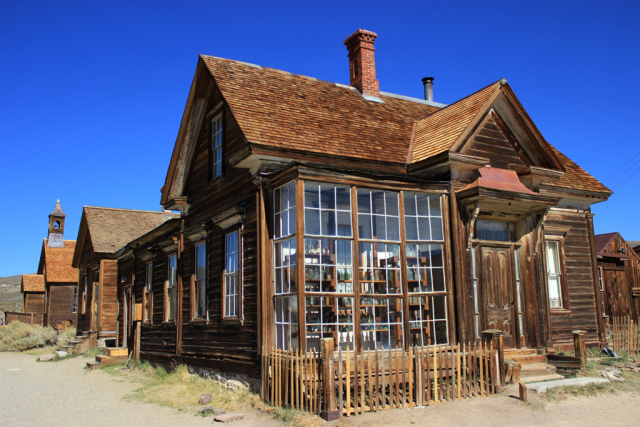
The J.S. Cain residence. He purportedly mined $90,000 in gold in 90 days on a plot of ground leased from Standard Mine and Mill, which refused to renew his lease. That amounts to over $2 million in 2012 dollars.
Bodie Fire Dept


Bodie Graveyard
 Victorian Hearse in Bodie
Victorian Hearse in Bodie
This grave is labeled, Pagdin. You will notice there is a big hole in the marker. It is unusually thick and hollow. There is some thought that this was actually used to store bottles of liquor during the prohibition era. There were some investigations and busts in Bodie during that time.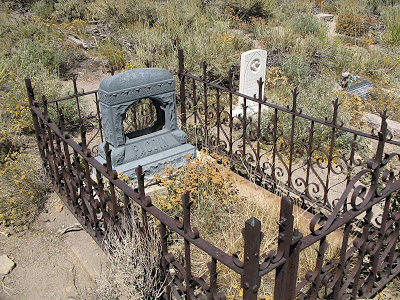

James Perry, a native of Ireland, died on June 9, 1863. He was 63 years old. You can see the "all seeing eye" and the odd fellows emblem. He was a Mono County Supervisor and miner. The fire of 1892 started in his wife's restaurant.
 Killings occurred with monotonous regularity, sometimes becoming almost daily events. The fire bell, which tolled the ages of the deceased when they were buried, rang often and long.
Hotels
Killings occurred with monotonous regularity, sometimes becoming almost daily events. The fire bell, which tolled the ages of the deceased when they were buried, rang often and long.
Hotels
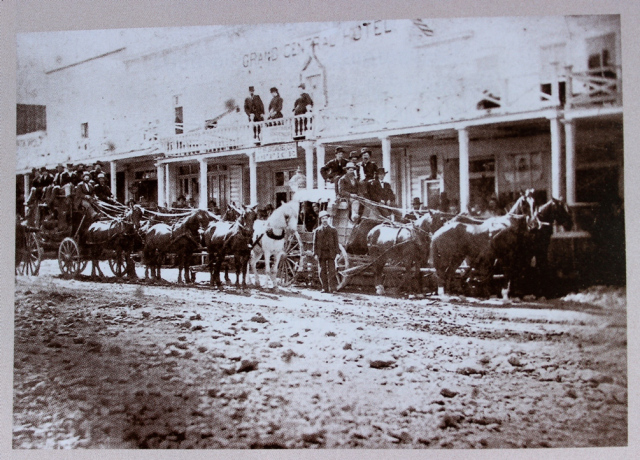 Stagecoaches in front of the Grand Central Hotel on Main Street in 1880.
Stagecoaches in front of the Grand Central Hotel on Main Street in 1880.

This is a picture of the U.S. Hotel. It was wiped out in the big fire of June 23, 1932. In the 1920's, a chinese man by the name of Sam Leon owned the U.S. Hotel. When the hotel burned down he moved down across the street to start his new bar (or cafe). In the first picture above, it is part of the first structure you see on the right side of the street.
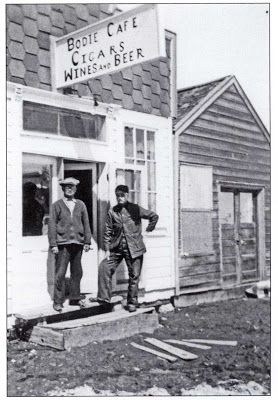
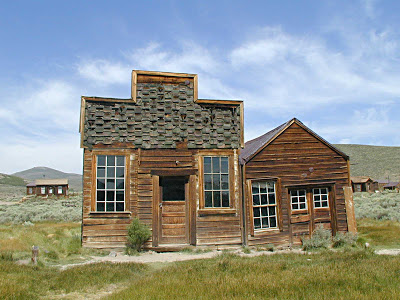
Sam Leon is the one of the left. The barbershop is on the right. Eventually, he moved his business to the DeChambeau Hotel. Here is one of my pictures from some years back.
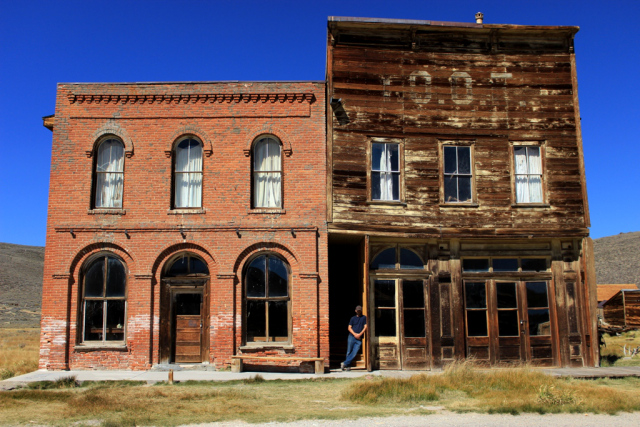 Dechambeau Hotel and Post Office on the left. The Bodie Independent Order of Odd Fellows (I.O.O.F.) used the upper floor of the building on the right, which also housed the Bodie Athletic Club and at one time an undertaker’s business.
Dechambeau Hotel and Post Office on the left. The Bodie Independent Order of Odd Fellows (I.O.O.F.) used the upper floor of the building on the right, which also housed the Bodie Athletic Club and at one time an undertaker’s business.
 Old Bootjack Dance Hall
Old Bootjack Dance Hall
 The park is open year round but due to its elevation at 8,375 feet, it is accessible in winter only by snowmobile, skies or snowshoes.
The park is open year round but due to its elevation at 8,375 feet, it is accessible in winter only by snowmobile, skies or snowshoes.

Tucked away in the hills of Mono County is Bodie, with scarce 800 inhabitants. It is a peaceful, respectable town now, but time was when it contained 12,000 erring and excitable souls. Then “a bad man from Bodie” was a synonym for wickedness and daredeviltry, throughout the state, and Bodie, knowing this, was proud and tried to live up to its reputation.
It succeeded. Nowhere this side of the Rocky Mountains were there more wanton killings. Nowhere were more reckless displays of daring. It was a happy hearted time. If men died with great suddenness they also lived to the full every hour of their lives. Money was plentiful, for the mines were panning out and paying well. The numerous dance halls and gambling halls could be relied on to furnish ample excitement, and when this palled there were always shooting scrapes, lynchings, funerals, and then more shooting scrapes.
—Introduction to an article written by Maude Grange and published in the San Francisco Call newspaper on July 7, 1907
Bodie is becoming a quiet summer resort—no one killed here last week.
—Bodie Daily Free Press 1881
 Bodie is an historic gold mining ghost town located at over 8000 feet elevation on the eastern edge of the Sierra Nevada Mountains in Mono County, California. During its heyday in the 1880s it was a stereotypical bustling, rough-and-tumble boom town of the American west.
Drinking, gambling, violence and prostitution seemed to be favorite pastimes along with opium parlors, though other upright citizens carried on more tempered and respectable family lives.
According to the book “Saga of Wells Fargo,” there were 30 mines operating in Bodie during its height of activity and establishments that served alcohol numbered “something better than one to a mineshaft.” This for a town of 5,416 people, according to the U.S. census count taken in mid-1880, though estimates vary.
Bodie is an historic gold mining ghost town located at over 8000 feet elevation on the eastern edge of the Sierra Nevada Mountains in Mono County, California. During its heyday in the 1880s it was a stereotypical bustling, rough-and-tumble boom town of the American west.
Drinking, gambling, violence and prostitution seemed to be favorite pastimes along with opium parlors, though other upright citizens carried on more tempered and respectable family lives.
According to the book “Saga of Wells Fargo,” there were 30 mines operating in Bodie during its height of activity and establishments that served alcohol numbered “something better than one to a mineshaft.” This for a town of 5,416 people, according to the U.S. census count taken in mid-1880, though estimates vary.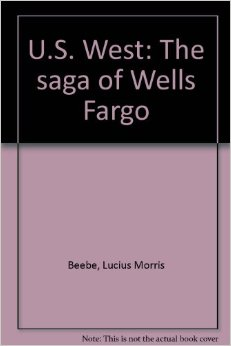 “The workingman off duty was confronted with a bewildering choice of oases on which to lavish his patronage,” reads the book. “At all of these, the products of the town’s three breweries—the Bodie, the Pioneer, Pat Fahey’s—were the favored chasers. … The river of life flowed at its fullest in Bodie, both around and through its citizens.”
Today about five percent of the town’s historic buildings remain and the site is a designated State Historic Park.
“The workingman off duty was confronted with a bewildering choice of oases on which to lavish his patronage,” reads the book. “At all of these, the products of the town’s three breweries—the Bodie, the Pioneer, Pat Fahey’s—were the favored chasers. … The river of life flowed at its fullest in Bodie, both around and through its citizens.”
Today about five percent of the town’s historic buildings remain and the site is a designated State Historic Park.

Bodie has been the subject of much myth making and exaggeration, and inaccuracies either intentionally or unwittingly promoted and repeated. Some of which have, apparently, been included in the official State Park literature. Michael H. Piatt, author of “Bodie: ‘The Mines Are Looking Well …’,” has written about and debunked some of the most prominent myths (bodiehistory.com).
The following text is taken from the visitors brochure:
Bodie was named after Waterman S. Body (also known as William S. Bodey), who discovered gold here in 1859. The change in spelling of the town’s name has often been attributed to an illiterate sign painter, but it was a deliberate change by the citizenry to ensure proper pronunciation.
The town of Bodie rose to prominence with the decline of mining along the western slope of the Sierra Nevada. Prospectors crossing the eastern slope in 1859 to “see the elephant”—that is, to search for gold—made a rich discovery at Virginia City. This huge gold strike, later to be known as the Comstock Lode, started a wild rush to the surrounding high desert country.
By 1879 Bodie boasted a population of about 10,000 and was second to none for wickedness, badmen, and the “worst climate out of doors.” One little girl, whose family was taking her to the remote and infamous town, wrote in her diary: “Goodbye God, I’m going to Bodie.” The phrase came to be known throughout the West.
Killings occurred with monotonous regularity, sometimes becoming almost daily events. The fire bell, which tolled the ages of the deceased when they were buried, rang often and loud. Robberies, stage holdups and street fights provided variety, and the town’s 65 saloons offered many opportunities for relaxation after hard days of work in the mines. The Reverend F. M. Warrington saw it in 1881 as “a sea of sin, lashed by the tempests of lust and passion.”
Nearly everyone has heard about the infamous “Badman of Bodie.” Some historians say that he was a real person by the name of Tom Adams. Others say his name was Washoe Pete. It seems more likely, however, that he was a composite. Bad men, like bad whiskey and bad climate, were endemic to the area. Whatever the case, the streets are quiet now. Bodie still has its wicked climate, but with the possible exception of an occasional ghostly visitor, its badmen are all in their graves.
Between 1860 and 1941, the Bodie Mining District produced close to $100 million in gold and silver. During those years, gold prices ranged from $20 to $35 an ounce; the price of silver ranged from 70 cents to $1 an ounce.

Methodist Church

 Bodie Schoolhouse
Bodie Schoolhouse
 Brodie Schoolhouse All of Davis Rosenthal’s children (Aaron, Samuel, Heneretta & Benjamin) attended this school, before they moved to Hawthorne, NV
Brodie Schoolhouse All of Davis Rosenthal’s children (Aaron, Samuel, Heneretta & Benjamin) attended this school, before they moved to Hawthorne, NV
“The small sawmill was used for cutting firewood. With snow as much as 20 feet deep, winds up to 100 miles and hour, and temperatures down to 30 or 40 degrees below zero, plenty of firewood was needed to keep Bodie’s poorly constructed houses warm during winter.”
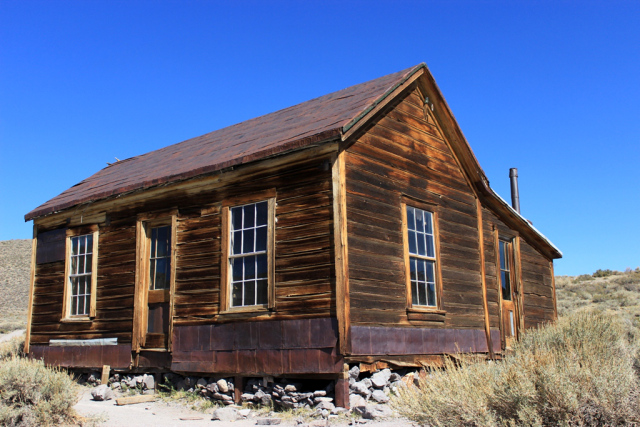
 The interior of a Bodie house.
The interior of a Bodie house.
Tin Roofs
Shingled roof made from recycled tin containers. Many of the houses in Bodie are cleverly faced or roofed in this manner.

 Lots of fascinating junk still sits rusting around Bodie. Old cars especially:
Lots of fascinating junk still sits rusting around Bodie. Old cars especially:
By 1879 Bodie boasted a population of 10,000 and was second to none for wickedness, badmen and "the worst climate out of doors." One little girl, whose family was taking her to the remote and infamous town, wrote in her diary: "Goodbye God, I'm going to Bodie." The phrase came to be known throughout the West.
The old general store has been turned into a small museum. Other than that, the buildings remain untouched. Sitting creepily in the back of that museum was this vintage hearse, which once plied the streets of Bodie with its morbid cargo. (Awesome band name: "Morbid Cargo.")
 Bodie Museum
Bodie Museum
Pat Reddy was a Bodie lawyer. Yes, he was the one who defended the "Bad Man from Bodie". On more than one occasion he kept supposedly guilty ment from being hanged. Pat was very well known for his abilities as a lawyer, and was call upon often.
James Stuart Cain
J.S. Cain came to Bodie at the age of 25 looking to make his fortune in business. He built an empire one piece at a time. One of his first businesses was barging timber across Mono Lake to Bodie. Timber was used for shoring up mines, building hoisting works, firing the wood-burning boilers for the steam engines, building homes and other structures AND it was used for cooking and heating!
Cain successfully ran mines, including being President of the Southern Consolidated Mining Co.; in 1890 he purchased the Bodie Bank from E. L. Benedict and began buying property around town. By the time California State Parks took over the town, the Cain family owned a majority of Bodie.
James S. Cain and Martha Cain, married in Carson City, Nevada, September 17, 1879
The J.S. Cain residence. He purportedly mined $90,000 in gold in 90 days on a plot of ground leased from Standard Mine and Mill, which refused to renew his lease. That amounts to over $2 million in 2012 dollars.
Bodie Fire Dept
Bodie Graveyard
Victorian Hearse in Bodie
This grave is labeled, Pagdin. You will notice there is a big hole in the marker. It is unusually thick and hollow. There is some thought that this was actually used to store bottles of liquor during the prohibition era. There were some investigations and busts in Bodie during that time.
James Perry, a native of Ireland, died on June 9, 1863. He was 63 years old. You can see the "all seeing eye" and the odd fellows emblem. He was a Mono County Supervisor and miner. The fire of 1892 started in his wife's restaurant.
Killings occurred with monotonous regularity, sometimes becoming almost daily events. The fire bell, which tolled the ages of the deceased when they were buried, rang often and long.
Hotels
Stagecoaches in front of the Grand Central Hotel on Main Street in 1880.
This is a picture of the U.S. Hotel. It was wiped out in the big fire of June 23, 1932. In the 1920's, a chinese man by the name of Sam Leon owned the U.S. Hotel. When the hotel burned down he moved down across the street to start his new bar (or cafe). In the first picture above, it is part of the first structure you see on the right side of the street.
Sam Leon is the one of the left. The barbershop is on the right. Eventually, he moved his business to the DeChambeau Hotel. Here is one of my pictures from some years back.
Dechambeau Hotel and Post Office on the left. The Bodie Independent Order of Odd Fellows (I.O.O.F.) used the upper floor of the building on the right, which also housed the Bodie Athletic Club and at one time an undertaker’s business.
Old Bootjack Dance Hall
The park is open year round but due to its elevation at 8,375 feet, it is accessible in winter only by snowmobile, skies or snowshoes.
Tucked away in the hills of Mono County is Bodie, with scarce 800 inhabitants. It is a peaceful, respectable town now, but time was when it contained 12,000 erring and excitable souls. Then “a bad man from Bodie” was a synonym for wickedness and daredeviltry, throughout the state, and Bodie, knowing this, was proud and tried to live up to its reputation.
It succeeded. Nowhere this side of the Rocky Mountains were there more wanton killings. Nowhere were more reckless displays of daring. It was a happy hearted time. If men died with great suddenness they also lived to the full every hour of their lives. Money was plentiful, for the mines were panning out and paying well. The numerous dance halls and gambling halls could be relied on to furnish ample excitement, and when this palled there were always shooting scrapes, lynchings, funerals, and then more shooting scrapes.
—Introduction to an article written by Maude Grange and published in the San Francisco Call newspaper on July 7, 1907
Bodie is becoming a quiet summer resort—no one killed here last week.
—Bodie Daily Free Press 1881
Bodie is an historic gold mining ghost town located at over 8000 feet elevation on the eastern edge of the Sierra Nevada Mountains in Mono County, California. During its heyday in the 1880s it was a stereotypical bustling, rough-and-tumble boom town of the American west.
Drinking, gambling, violence and prostitution seemed to be favorite pastimes along with opium parlors, though other upright citizens carried on more tempered and respectable family lives.
According to the book “Saga of Wells Fargo,” there were 30 mines operating in Bodie during its height of activity and establishments that served alcohol numbered “something better than one to a mineshaft.” This for a town of 5,416 people, according to the U.S. census count taken in mid-1880, though estimates vary.
“The workingman off duty was confronted with a bewildering choice of oases on which to lavish his patronage,” reads the book. “At all of these, the products of the town’s three breweries—the Bodie, the Pioneer, Pat Fahey’s—were the favored chasers. … The river of life flowed at its fullest in Bodie, both around and through its citizens.”
Today about five percent of the town’s historic buildings remain and the site is a designated State Historic Park.
Bodie has been the subject of much myth making and exaggeration, and inaccuracies either intentionally or unwittingly promoted and repeated. Some of which have, apparently, been included in the official State Park literature. Michael H. Piatt, author of “Bodie: ‘The Mines Are Looking Well …’,” has written about and debunked some of the most prominent myths (bodiehistory.com).
The following text is taken from the visitors brochure:
Bodie was named after Waterman S. Body (also known as William S. Bodey), who discovered gold here in 1859. The change in spelling of the town’s name has often been attributed to an illiterate sign painter, but it was a deliberate change by the citizenry to ensure proper pronunciation.
The town of Bodie rose to prominence with the decline of mining along the western slope of the Sierra Nevada. Prospectors crossing the eastern slope in 1859 to “see the elephant”—that is, to search for gold—made a rich discovery at Virginia City. This huge gold strike, later to be known as the Comstock Lode, started a wild rush to the surrounding high desert country.
By 1879 Bodie boasted a population of about 10,000 and was second to none for wickedness, badmen, and the “worst climate out of doors.” One little girl, whose family was taking her to the remote and infamous town, wrote in her diary: “Goodbye God, I’m going to Bodie.” The phrase came to be known throughout the West.
Killings occurred with monotonous regularity, sometimes becoming almost daily events. The fire bell, which tolled the ages of the deceased when they were buried, rang often and loud. Robberies, stage holdups and street fights provided variety, and the town’s 65 saloons offered many opportunities for relaxation after hard days of work in the mines. The Reverend F. M. Warrington saw it in 1881 as “a sea of sin, lashed by the tempests of lust and passion.”
Nearly everyone has heard about the infamous “Badman of Bodie.” Some historians say that he was a real person by the name of Tom Adams. Others say his name was Washoe Pete. It seems more likely, however, that he was a composite. Bad men, like bad whiskey and bad climate, were endemic to the area. Whatever the case, the streets are quiet now. Bodie still has its wicked climate, but with the possible exception of an occasional ghostly visitor, its badmen are all in their graves.
Between 1860 and 1941, the Bodie Mining District produced close to $100 million in gold and silver. During those years, gold prices ranged from $20 to $35 an ounce; the price of silver ranged from 70 cents to $1 an ounce.
Methodist Church
Bodie Schoolhouse
Brodie Schoolhouse All of Davis Rosenthal’s children (Aaron, Samuel, Heneretta & Benjamin) attended this school, before they moved to Hawthorne, NV
“The small sawmill was used for cutting firewood. With snow as much as 20 feet deep, winds up to 100 miles and hour, and temperatures down to 30 or 40 degrees below zero, plenty of firewood was needed to keep Bodie’s poorly constructed houses warm during winter.”
The interior of a Bodie house.
Tin Roofs
Shingled roof made from recycled tin containers. Many of the houses in Bodie are cleverly faced or roofed in this manner.
Lots of fascinating junk still sits rusting around Bodie. Old cars especially:
By 1879 Bodie boasted a population of 10,000 and was second to none for wickedness, badmen and "the worst climate out of doors." One little girl, whose family was taking her to the remote and infamous town, wrote in her diary: "Goodbye God, I'm going to Bodie." The phrase came to be known throughout the West.
The old general store has been turned into a small museum. Other than that, the buildings remain untouched. Sitting creepily in the back of that museum was this vintage hearse, which once plied the streets of Bodie with its morbid cargo. (Awesome band name: "Morbid Cargo.")
Hornitos, Mariposa Co., California
Hornitos, Mariposa Co., California

Home of the Davis & Augusta Rosenthal Family
Birthplace of Aaron A., Samuel Henry & Henrietta Kate Rosenthal. The Rosenthals were merchants and hoteliers who moved from here to Bodie, California to Hawthorne, Nevada following their customers, the miners.
Hornitos is located on Burns Creek 14 miles south of Coulterville at an elevation of 843 feet. Hornitos is located on CR-J16, 11 miles west of Bear Valley, and about 15 AIR miles west-northwest of Mariposa.
The Hornitos district is in the Sierra Nevada west gold belt in western Mariposa County about 15 miles west of the town of Mariposa (see fig. 4, Bulletin 193). The district contains a several-mile wide belt of lode-gold mines that extends from the vicinity of the Exchequer Reservoir SSE through Hornitos to the Indian Gulch area.

Originally, the nameless community was established by Mexican Miners in 1848. Mexican miners who were kicked out of the nearby town of Quartzburg founded Hornitos on Burns Creek, in the western edge of Mariposa County. It was quickly populated by“less desirable elements” evicted from the booming mining town of Quartzburg about two miles away. These evictees changed the character of the mining camp and Hornitos quickly became known as a rough community.
Hornitos went on to become one of the most prosperous towns of the Southern Motherload. Meanwhile, the placers at Quartzburg soon played out and that camp died away. Later it settled down and grew respectable as Quartzburg faded and the folks moved to nearby Hornitos. It was the center for both placer and hard rock mining.
 The ground in the area of Hornitos is very hard and rocky so the Mexican towns folks preferred to bury their dead in above ground tombs built of rock and adobe. These small dome-shaped mounds resembled the outdoor ovens used for baking bread in Mexico so the graves were known as "hornitos", which meant “little ovens” in Spanish.
The ground in the area of Hornitos is very hard and rocky so the Mexican towns folks preferred to bury their dead in above ground tombs built of rock and adobe. These small dome-shaped mounds resembled the outdoor ovens used for baking bread in Mexico so the graves were known as "hornitos", which meant “little ovens” in Spanish.
 The Hornitas post office opened in 1856, and changed its name to Hornitos in 1877.
The Hornitas post office opened in 1856, and changed its name to Hornitos in 1877.

 Hornitos Hotel today.
Hornitos Hotel today.
By the mid-late 1850s Hornitos was a small city with some 6000 people. It was well known for its fiestas, fandangos, gambling and violence. The mining camp grew quickly around a central plaza, rock and adobe buildings lined the narrow streets running out from the center of town. During its heyday, Hornitos is said to have had a population of less than 8,000. The town had 4 hotels, 6 fraternal lodges and organizations, a post office, 6 general merchandise stores, a Wells Fargo Express, and several saloons and fandango halls. Many of the fandangos were built underground and lined the road leading to the plaza. These subterranean saloons were all connected by doors so patrons could roam from one to another without the inconvenience of having go outside, where they might be seen.
 Pacific Saloon, built in 1851 of adobe construction, in 1862 the brick trim was added.
Pacific Saloon, built in 1851 of adobe construction, in 1862 the brick trim was added.
 Old adobe ruins with only the entry way and it's iron doors remaining. Photo courtesy of Lewis Shorb, Ghost Town Explorers
Old adobe ruins with only the entry way and it's iron doors remaining. Photo courtesy of Lewis Shorb, Ghost Town Explorers
The Ghirardelli Store
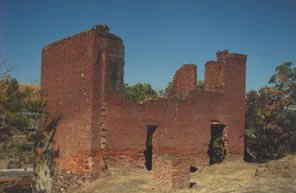 The Ghirardelli Store (1859) was operated by D. Ghirardelli & Co., the well-known chocolate maker of San Francisco. (Courtesy Dolores Steele)
The Ghirardelli Store (1859) was operated by D. Ghirardelli & Co., the well-known chocolate maker of San Francisco. (Courtesy Dolores Steele)

Pacific Saloon, built in 1851 of adobe construction, in 1862 the brick trim was added.
Outlaws, Jail & Dead Man's Gulch
 Jail -- Granite walls 2 feet thick (Courtesy Dolores Steele)
Jail -- Granite walls 2 feet thick (Courtesy Dolores Steele)
But the town has a dark history to it as well. The town was so notorious for its daily gunfights that the dead outlaws were simply dumped into a deep gully called Dead Man's Gulch. Famed Mexican bandit, Joaquin Murieta, was said to frequent the fandango halls and was rumored to have been almost captured in the town in the 1850's.
Joaquin Murieta
 The infamous bandit/folk hero, Joaquin Murieta was almost captured here in the early 1850’s but slipped away. Though the official line is that Murieta was eventually caught, killed, and his severed head paraded about the state, many people thought it was faked and that he retired from his Robin Hood’ish ways to live off riches he’d stashed away. One version of that story puts Hornitos as the place he buried his gold. Joaquin Murieta was the basis for the fictional character of Zorro. It is claimed that the infamous bandit Joaquin MURIETTA is said to have frequented the dance halls and saloons here, and is said to have had a secret escape tunnel from his favorite hangouts. However much of what was written about this outlaw has almost reached legendary proportions and it is difficult to separate fact from fancy. (Kind of like the Earp clan and James Brothers.
The infamous bandit/folk hero, Joaquin Murieta was almost captured here in the early 1850’s but slipped away. Though the official line is that Murieta was eventually caught, killed, and his severed head paraded about the state, many people thought it was faked and that he retired from his Robin Hood’ish ways to live off riches he’d stashed away. One version of that story puts Hornitos as the place he buried his gold. Joaquin Murieta was the basis for the fictional character of Zorro. It is claimed that the infamous bandit Joaquin MURIETTA is said to have frequented the dance halls and saloons here, and is said to have had a secret escape tunnel from his favorite hangouts. However much of what was written about this outlaw has almost reached legendary proportions and it is difficult to separate fact from fancy. (Kind of like the Earp clan and James Brothers.
 Masonic Lodge built sometime in the 1850's.
Photo courtesy of Lewis Shorb, Ghost Town Explorers
Masonic Lodge built sometime in the 1850's.
Photo courtesy of Lewis Shorb, Ghost Town Explorers
Hornitos Cemetery & St Catherine's Church

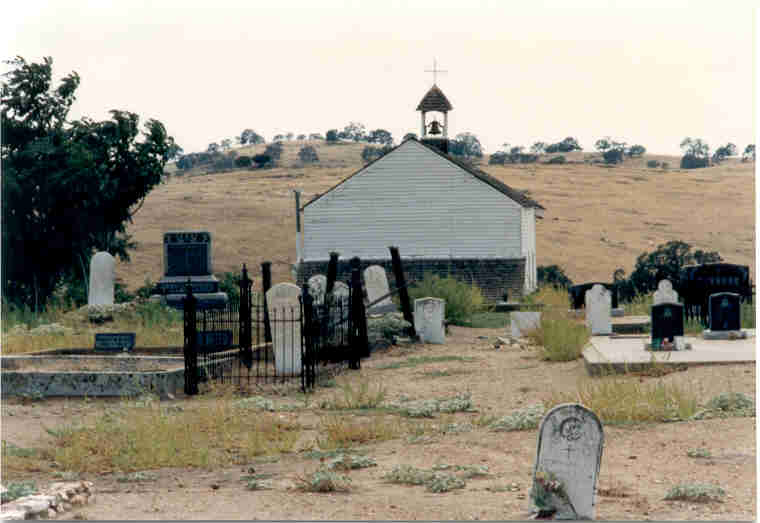

Gold & Mining

Golf History
The streams around Hornitos were rich in gold, with reports of nuggets weighing up to 34 pounds being found in the area. When the placers began to give out, the miners started digging shafts and tunnels to reach the quartz gold lying below the rocky surface.
In 1858 the first quartz mill was installed. It was a machine-powered arrastra. By 1860 it had been replaced by a 20-stamp mill. In 1900 there were four operating stamp mills in the community. It is claimed that some $40,000 in gold was shipped out on a daily basis.
The streams in the area were first worked in 1849, and lode mining began in 1850 at the Washington Mine. activity was great from the 1860's through the 1880's, lesser from the 1890's to the 1920's. The Mt. Gaines Mine was worked on a major scale during the 1930s. Since World War II the area has been prospected, but there has been very little recorded production. Historically, this is the most productive district of the Sierra Nevada West gold belt. By 1870 the population is said to have reached 15,000, and the town incorporated as Mariposa County’s only incorporated city.

Hornitos was in the center of the HORNITOS MINING DISTRICT.
Some of the mines in that district include:
BADGER MINE, BARCROFT MINE, CHITTENDEN’S MINE, DOSS MINE, DUNCAN MINE, EUREKA MINE (#1), GAINES MINE, JENNY LIND MINE, LONDON MINE, LOST DOUGLAS, MARTINEZ, MOUNT GAINES MINE, NUMBER 1 MINE, NUMBER 4 MINE, NUMBER 5 MINE, NUMBER 7 MINE, NUMBER 8 MINE, NUMBER 9 MINE, PRESCOTT VEIN , QUARTZ MOUNTAIN MINE, RUTH PIERCE MINE, WASHINGTON MINE (#1), YOSEMITE MILL
Chinese in Hornitos & China John
Chinese Section: Off to the east side of town a thriving Chinese section grew to house some 2000 folks.
There is one story that is often remembered of the old stone jail and it is a tragic tale. During the 1860’s Hornitos was home to a large Chinese population, many of whom were engaged in reworking the abandoned claims in the area.

Tradition has it that one such miner was known as China John. While working on his claim one morning, a group of young boys gathered about him, teasing him and making a nuisance of themselves as young boys will do. This annoying bedevilment continued for several days until China John finally snapped. Reaching into his pocket, he drew a battered pistol and fired into the side of a hill to frighten the boys away. Unfortunately, the shot struck a stone in the hill, ricocheted and hit one of the boys in the leg. The boys scattered, screaming, and China John was glued to the spot, horrified by what he had done. Nearby miners raced to the scene, grabbed China John and dragged him back towards the plaza. An angry mob, infuriated by the news that a Chinaman had shot a white boy, quickly gathered and men began looking for a rope. The boy was little more than scratched by the bullet, but no one bothered to find this out. Just as the unruly crowd was about to string China John up, several town officials appeared and were able to quiet down the vocal mob.
Assured that there would be a trail the following day (and that a hanging would certainly follow), the mob began to break up and the prisoner was taken to the stone jail to await the coming morrow. As he was not considered dangerous, China John was not shackled to the floor. Late that night, a quiet group of men stealthily approached the jail. Drawing their guns, several men entered the guardhouse, surprising and tying up the guard; but the keys were nowhere to be found. Even though there was no way into the jail, they had their hangman’s noose ready and it would be used that night.
Hornitos, Mariposa Co., California
Home of the Davis & Augusta Rosenthal Family
Birthplace of Aaron A., Samuel Henry & Henrietta Kate Rosenthal. The Rosenthals were merchants and hoteliers who moved from here to Bodie, California to Hawthorne, Nevada following their customers, the miners.
|
Hornitos is located on Burns Creek 14 miles south of Coulterville at an elevation of 843 feet. Hornitos is located on CR-J16, 11 miles west of Bear Valley, and about 15 AIR miles west-northwest of Mariposa.
The Hornitos district is in the Sierra Nevada west gold belt in western Mariposa County about 15 miles west of the town of Mariposa (see fig. 4, Bulletin 193). The district contains a several-mile wide belt of lode-gold mines that extends from the vicinity of the Exchequer Reservoir SSE through Hornitos to the Indian Gulch area.
Originally, the nameless community was established by Mexican Miners in 1848. Mexican miners who were kicked out of the nearby town of Quartzburg founded Hornitos on Burns Creek, in the western edge of Mariposa County. It was quickly populated by“less desirable elements” evicted from the booming mining town of Quartzburg about two miles away. These evictees changed the character of the mining camp and Hornitos quickly became known as a rough community.
Hornitos went on to become one of the most prosperous towns of the Southern Motherload. Meanwhile, the placers at Quartzburg soon played out and that camp died away. Later it settled down and grew respectable as Quartzburg faded and the folks moved to nearby Hornitos. It was the center for both placer and hard rock mining.
The ground in the area of Hornitos is very hard and rocky so the Mexican towns folks preferred to bury their dead in above ground tombs built of rock and adobe. These small dome-shaped mounds resembled the outdoor ovens used for baking bread in Mexico so the graves were known as "hornitos", which meant “little ovens” in Spanish.
Hornitos Hotel today.
By the mid-late 1850s Hornitos was a small city with some 6000 people. It was well known for its fiestas, fandangos, gambling and violence. The mining camp grew quickly around a central plaza, rock and adobe buildings lined the narrow streets running out from the center of town. During its heyday, Hornitos is said to have had a population of less than 8,000. The town had 4 hotels, 6 fraternal lodges and organizations, a post office, 6 general merchandise stores, a Wells Fargo Express, and several saloons and fandango halls. Many of the fandangos were built underground and lined the road leading to the plaza. These subterranean saloons were all connected by doors so patrons could roam from one to another without the inconvenience of having go outside, where they might be seen.
Pacific Saloon, built in 1851 of adobe construction, in 1862 the brick trim was added.
Old adobe ruins with only the entry way and it's iron doors remaining. Photo courtesy of Lewis Shorb, Ghost Town Explorers
The Ghirardelli Store
The Ghirardelli Store (1859) was operated by D. Ghirardelli & Co., the well-known chocolate maker of San Francisco. (Courtesy Dolores Steele)
Pacific Saloon, built in 1851 of adobe construction, in 1862 the brick trim was added.
Outlaws, Jail & Dead Man's Gulch
Jail -- Granite walls 2 feet thick (Courtesy Dolores Steele)
But the town has a dark history to it as well. The town was so notorious for its daily gunfights that the dead outlaws were simply dumped into a deep gully called Dead Man's Gulch. Famed Mexican bandit, Joaquin Murieta, was said to frequent the fandango halls and was rumored to have been almost captured in the town in the 1850's.
Joaquin Murieta
Masonic Lodge built sometime in the 1850's.
Photo courtesy of Lewis Shorb, Ghost Town Explorers
Hornitos Cemetery & St Catherine's Church
Gold & Mining
Golf History
The streams around Hornitos were rich in gold, with reports of nuggets weighing up to 34 pounds being found in the area. When the placers began to give out, the miners started digging shafts and tunnels to reach the quartz gold lying below the rocky surface.
In 1858 the first quartz mill was installed. It was a machine-powered arrastra. By 1860 it had been replaced by a 20-stamp mill. In 1900 there were four operating stamp mills in the community. It is claimed that some $40,000 in gold was shipped out on a daily basis.
The streams in the area were first worked in 1849, and lode mining began in 1850 at the Washington Mine. activity was great from the 1860's through the 1880's, lesser from the 1890's to the 1920's. The Mt. Gaines Mine was worked on a major scale during the 1930s. Since World War II the area has been prospected, but there has been very little recorded production. Historically, this is the most productive district of the Sierra Nevada West gold belt. By 1870 the population is said to have reached 15,000, and the town incorporated as Mariposa County’s only incorporated city.
Hornitos was in the center of the HORNITOS MINING DISTRICT.
Some of the mines in that district include:
BADGER MINE, BARCROFT MINE, CHITTENDEN’S MINE, DOSS MINE, DUNCAN MINE, EUREKA MINE (#1), GAINES MINE, JENNY LIND MINE, LONDON MINE, LOST DOUGLAS, MARTINEZ, MOUNT GAINES MINE, NUMBER 1 MINE, NUMBER 4 MINE, NUMBER 5 MINE, NUMBER 7 MINE, NUMBER 8 MINE, NUMBER 9 MINE, PRESCOTT VEIN , QUARTZ MOUNTAIN MINE, RUTH PIERCE MINE, WASHINGTON MINE (#1), YOSEMITE MILL
|
Chinese in Hornitos & China John
Chinese Section: Off to the east side of town a thriving Chinese section grew to house some 2000 folks.
Chinese Section: Off to the east side of town a thriving Chinese section grew to house some 2000 folks.
There is one story that is often remembered of the old stone jail and it is a tragic tale. During the 1860’s Hornitos was home to a large Chinese population, many of whom were engaged in reworking the abandoned claims in the area.
Tradition has it that one such miner was known as China John. While working on his claim one morning, a group of young boys gathered about him, teasing him and making a nuisance of themselves as young boys will do. This annoying bedevilment continued for several days until China John finally snapped. Reaching into his pocket, he drew a battered pistol and fired into the side of a hill to frighten the boys away. Unfortunately, the shot struck a stone in the hill, ricocheted and hit one of the boys in the leg. The boys scattered, screaming, and China John was glued to the spot, horrified by what he had done. Nearby miners raced to the scene, grabbed China John and dragged him back towards the plaza. An angry mob, infuriated by the news that a Chinaman had shot a white boy, quickly gathered and men began looking for a rope. The boy was little more than scratched by the bullet, but no one bothered to find this out. Just as the unruly crowd was about to string China John up, several town officials appeared and were able to quiet down the vocal mob.
Assured that there would be a trail the following day (and that a hanging would certainly follow), the mob began to break up and the prisoner was taken to the stone jail to await the coming morrow. As he was not considered dangerous, China John was not shackled to the floor. Late that night, a quiet group of men stealthily approached the jail. Drawing their guns, several men entered the guardhouse, surprising and tying up the guard; but the keys were nowhere to be found. Even though there was no way into the jail, they had their hangman’s noose ready and it would be used that night.
The next morning they found China John, lying broken on the floor in a pool of blood, beneath the small, barred window, the hangman’s noose knotted around his neck. Somehow the men had lured him to the window, perhaps with the offer of drugs or tobacco. Once there, he was grabbed and held as the noose was slipped over his head and pulled tight against his throat. Then with repeated jerks and pulls on the rope, China John’s brains were bashed out against the rock wall. Even for Hornitos, this was a wanton, brutal murder which shocked the citizens upon its discovery. Those responsible were never brought to justice. The evidence of this vicious crime remained visible for many years in the form of bloodstains on the wall of the jail. But in 1902 a coating of lime was applied to the inside walls and the tell-tale marks were covered from view.
Businesses
Some of the early businesses included a blacksmith shop, brewery (1860), butcher, several dance halls, adobe-walled jail (1853), six lodges, general stores, post office (est. June 18, 1856) and a Wells Fargo & Company Express Office (1853).
At the time of ots incorporation Hornitos had a dozen hotels and 36 saloons along with many other businesses. Some of the many businesses that existed here include:
 Butchers: George REEB’s Butcher shop. Reeb’s butcher shop, at corner of Plaza, Hornitos
Butchers: George REEB’s Butcher shop. Reeb’s butcher shop, at corner of Plaza, Hornitos
 Dance-hall of 1850 at Hornitos, with an underground passage for escape when things grew too hot. Rosie Martinez built Hornitos’ only two-story
dance hall in 1851.
Dance-hall of 1850 at Hornitos, with an underground passage for escape when things grew too hot. Rosie Martinez built Hornitos’ only two-story
dance hall in 1851.
 Cassaretto Store built in 1851 The Cassaretto Store was built in 1851 of stone and adobe, the outer walls were later coated with a lime mortar. Originally a Mexican store.
Cassaretto Store built in 1851 The Cassaretto Store was built in 1851 of stone and adobe, the outer walls were later coated with a lime mortar. Originally a Mexican store.
 C.B. Cavagnaro's General Store, Hornitos, California
C.B. Cavagnaro's General Store, Hornitos, California
 The Gagliardo & Co. Store
Entertainment: Many of the businesses were interconnected with underground tunnels, and for entertainment besides the Fandango Dance Halls there were always chicken races, bull & bear fights and cock-fights. . Life was NOT boring!
The Gagliardo & Co. Store
Entertainment: Many of the businesses were interconnected with underground tunnels, and for entertainment besides the Fandango Dance Halls there were always chicken races, bull & bear fights and cock-fights. . Life was NOT boring!
Decline
But good things don’t always last forever, and mining slowed and the people began to move on. By the mid 1880s Hornitos was much quieter, and it didn’t take a lot to get the folks excited. The following information came from an unidentified 1884 newspaper clipping. Contributed to the Mariposa County Discussion List by William Disbro.
Hornitos, Aug. 13th, 1884
“The monotony of our existence was rudely disturbed last Sunday evening by the cry of "fire." Towards nine o'clock, while everyone was calmly enjoying the cool evening, after a day when the thermometer was among the hundreds, when people were sitting quietly before their doors, chatting on various topics, discussing the mysterious origin of the numerous fires and the burning done on the GRIFFITHS Ranch, some one startled us with the announcement that ‘George REEB’S house burning.’ In a instant the whole town was in commotion. Men were running with hoses, tubs and buckets; some pumping, others shouting, children crying and women, scared by the reminiscences of early day fires, when the whole of our town was swept clean out in a few hours, were packing their household goods, making ready to move in case of need. For a moment the wind blew south and the whole northern part of town was enveloped in a thick cloud of dense, black smoke that compelled everyone to close windows and doors. Then it veered again. A pile of fifty tons of baled hay was ablaze and one single glance sufficed to reveal the fact that it was past redemption, and that our efforts must be concentrated in keeping the fire from spreading. A difficult task indeed, with old tumble down buildings, built in the prosperous days of Hornitos, abutting right smack against the fire, roof made as dry as tinder by the summer heat and ready to blaze up at the least spark!
“Luckily, the wind fell to a dead calm. The moon rose and we were working in the dark no more. The tin roof gradually giving us a show to keep down flames and sparks and thus confining the conflagration to one building. Everyone worked with a will, even the ladies, carrying water and pumping like good fellows and by two o'clock in the morning the town was saved.
“As I write, three days after the fire, it is still smoldering with prospects of keeping it up a few days unless some charitable soul turns on a stream of water, and I would suggest to our butcher, whose property it is, to kill a few of his hogs and smoke a few hams. In hard times let us be saving and make the best we can of a calamity.
“Yesterday, we had another narrow escape. By some means, a mosquito bar (netting) caught fire, and of course, the women were nearby, dropped it and yelled. But a few kicks and stamps and drops of water put that fire out. Otherwise our town is dull. Not even a dogfight or foot race. The infernal mluing (sic) of a band of tom cats is the only thing that disturbs the silence of the night. The solitary " drunk" I've seen for month of Sundays sang himself to sleep in jail, and the place has resumed its wonted calm and folks go indoors during the heat of the day, leaving the street in full possession of a few emaciated pigs, who solemnly perambulate the length and breath of Hornitos.
“The BARCROFT mine is turning out very well and the outlook for it is very promising. As yet, no clean up has been made, and therefore no decisive opinion can be formed, but it is the general impression of all experienced miners that it will be fully equal to anything yet found around this part of the county.”
By 1896 the calm deepened, and two saloons remained open to assuage the thirst of the residents. Hornitos has continued to fade until the 1980s, but then it was more of a rural refuge for disenfranchised urban dwellers looking for a little quiet. Hornitos disincorporated in 1953.
Today standing and ruined buildings remain, making Hornitos one of the most picturesque of the old mining towns.
Once the gold was exhausted the miners moved on to richer claims and Hornitos quietly died. There are a few residents found here today living among the gold rush era ruins. Eventually the gold ran out and the miners who populated the town moved onto other places in search of riches. From a population of around 15,000 in 1879 it quickly dwindled down and around 1932 there were roughly 60 people living in Hornitos. Today the population is 75 people and Hornitos is considered one of the best preserved ghost towns in the Mother Lode country

Ghosts of Prostitutes
Near the town square the ghosts of two prostitutes, who using knives and fought to the death over a miner, can still be felt to this day. The fight was over whose client he was and before the fight was over the miner had snuck off When the proverbial dust had settled, one of the women lay dead on the street and the was other badly injured. It's said if you stand still in the town square and listen you can still hear the screams of the women as they fought and the cheers of the miners who stood around and watched.
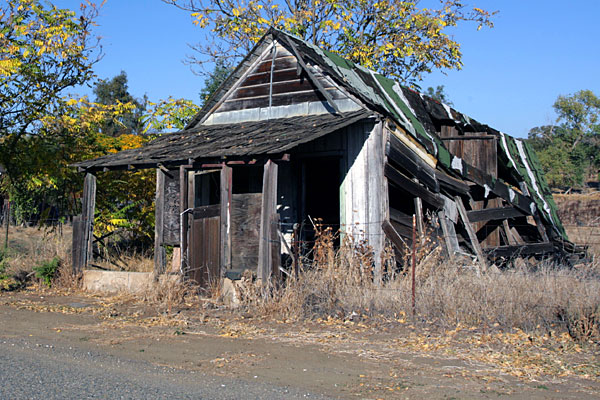


Sign Reads:
One of the Nations Most Famous Ghost Towns early population 15,000. Here was the first Wells Fargo Express Office in county. $40000 in gold sent to Mint daily by armed stagecoach.
Joaquin Murietta’s playground. California’s most colorful bandit. Mariposa County biggest county in the world during greatest Gold Rush of all time. Hornitos Spanish for “Little Ovens,” so named because of the Mexican burial tombs were shaped like square ovens – Hornitos Oldest Landmark
Hornitos is registered as California Historical Landmark #333.
 A Mexican-style plaza. It was built in 1851. The left end was a saloon. The right end was a saddle shop (Henning Olesen of Denmark & Florin's book.)
A Mexican-style plaza. It was built in 1851. The left end was a saloon. The right end was a saddle shop (Henning Olesen of Denmark & Florin's book.)
 A street in Hornitos just catches, along the left side, the plaza building (April 11, 1993.)
A street in Hornitos just catches, along the left side, the plaza building (April 11, 1993.)
 Hornitos buildings, including the General Merchandise store (Carter's book 1971).
Hornitos buildings, including the General Merchandise store (Carter's book 1971).
Today Hornitos lives on as one of the best preserved ghost towns in the Mother Lode with the ruins of the old Wells Fargo office, the stone Masonic Hall, the jailhouse, the store where the firm of D. Ghirardelli got its start in the 1850s and others.
The population was 75 at the 2010 census.
POPULATION FIGURES
· 1860: 6000 (not verified)
· 1870: 15,000 (not verified)
· 1930 – 62
· 1970 - 73
· 1980 - 200
· 1990 - 260
· 2000 - 260
Businesses
Some of the early businesses included a blacksmith shop, brewery (1860), butcher, several dance halls, adobe-walled jail (1853), six lodges, general stores, post office (est. June 18, 1856) and a Wells Fargo & Company Express Office (1853).
At the time of ots incorporation Hornitos had a dozen hotels and 36 saloons along with many other businesses. Some of the many businesses that existed here include:
Butchers: George REEB’s Butcher shop. Reeb’s butcher shop, at corner of Plaza, Hornitos
Dance-hall of 1850 at Hornitos, with an underground passage for escape when things grew too hot. Rosie Martinez built Hornitos’ only two-story
dance hall in 1851.
Cassaretto Store built in 1851 The Cassaretto Store was built in 1851 of stone and adobe, the outer walls were later coated with a lime mortar. Originally a Mexican store.
C.B. Cavagnaro's General Store, Hornitos, California
The Gagliardo & Co. Store
Entertainment: Many of the businesses were interconnected with underground tunnels, and for entertainment besides the Fandango Dance Halls there were always chicken races, bull & bear fights and cock-fights. . Life was NOT boring!
Decline
But good things don’t always last forever, and mining slowed and the people began to move on. By the mid 1880s Hornitos was much quieter, and it didn’t take a lot to get the folks excited. The following information came from an unidentified 1884 newspaper clipping. Contributed to the Mariposa County Discussion List by William Disbro.
Hornitos, Aug. 13th, 1884
“The monotony of our existence was rudely disturbed last Sunday evening by the cry of "fire." Towards nine o'clock, while everyone was calmly enjoying the cool evening, after a day when the thermometer was among the hundreds, when people were sitting quietly before their doors, chatting on various topics, discussing the mysterious origin of the numerous fires and the burning done on the GRIFFITHS Ranch, some one startled us with the announcement that ‘George REEB’S house burning.’ In a instant the whole town was in commotion. Men were running with hoses, tubs and buckets; some pumping, others shouting, children crying and women, scared by the reminiscences of early day fires, when the whole of our town was swept clean out in a few hours, were packing their household goods, making ready to move in case of need. For a moment the wind blew south and the whole northern part of town was enveloped in a thick cloud of dense, black smoke that compelled everyone to close windows and doors. Then it veered again. A pile of fifty tons of baled hay was ablaze and one single glance sufficed to reveal the fact that it was past redemption, and that our efforts must be concentrated in keeping the fire from spreading. A difficult task indeed, with old tumble down buildings, built in the prosperous days of Hornitos, abutting right smack against the fire, roof made as dry as tinder by the summer heat and ready to blaze up at the least spark!
“Luckily, the wind fell to a dead calm. The moon rose and we were working in the dark no more. The tin roof gradually giving us a show to keep down flames and sparks and thus confining the conflagration to one building. Everyone worked with a will, even the ladies, carrying water and pumping like good fellows and by two o'clock in the morning the town was saved.
“As I write, three days after the fire, it is still smoldering with prospects of keeping it up a few days unless some charitable soul turns on a stream of water, and I would suggest to our butcher, whose property it is, to kill a few of his hogs and smoke a few hams. In hard times let us be saving and make the best we can of a calamity.
“Yesterday, we had another narrow escape. By some means, a mosquito bar (netting) caught fire, and of course, the women were nearby, dropped it and yelled. But a few kicks and stamps and drops of water put that fire out. Otherwise our town is dull. Not even a dogfight or foot race. The infernal mluing (sic) of a band of tom cats is the only thing that disturbs the silence of the night. The solitary " drunk" I've seen for month of Sundays sang himself to sleep in jail, and the place has resumed its wonted calm and folks go indoors during the heat of the day, leaving the street in full possession of a few emaciated pigs, who solemnly perambulate the length and breath of Hornitos.
“The BARCROFT mine is turning out very well and the outlook for it is very promising. As yet, no clean up has been made, and therefore no decisive opinion can be formed, but it is the general impression of all experienced miners that it will be fully equal to anything yet found around this part of the county.”
By 1896 the calm deepened, and two saloons remained open to assuage the thirst of the residents. Hornitos has continued to fade until the 1980s, but then it was more of a rural refuge for disenfranchised urban dwellers looking for a little quiet. Hornitos disincorporated in 1953.
Today standing and ruined buildings remain, making Hornitos one of the most picturesque of the old mining towns.
Once the gold was exhausted the miners moved on to richer claims and Hornitos quietly died. There are a few residents found here today living among the gold rush era ruins. Eventually the gold ran out and the miners who populated the town moved onto other places in search of riches. From a population of around 15,000 in 1879 it quickly dwindled down and around 1932 there were roughly 60 people living in Hornitos. Today the population is 75 people and Hornitos is considered one of the best preserved ghost towns in the Mother Lode country
Ghosts of Prostitutes
Near the town square the ghosts of two prostitutes, who using knives and fought to the death over a miner, can still be felt to this day. The fight was over whose client he was and before the fight was over the miner had snuck off When the proverbial dust had settled, one of the women lay dead on the street and the was other badly injured. It's said if you stand still in the town square and listen you can still hear the screams of the women as they fought and the cheers of the miners who stood around and watched.
Sign Reads:
One of the Nations Most Famous Ghost Towns early population 15,000. Here was the first Wells Fargo Express Office in county. $40000 in gold sent to Mint daily by armed stagecoach.
Joaquin Murietta’s playground. California’s most colorful bandit. Mariposa County biggest county in the world during greatest Gold Rush of all time. Hornitos Spanish for “Little Ovens,” so named because of the Mexican burial tombs were shaped like square ovens – Hornitos Oldest Landmark
Hornitos is registered as California Historical Landmark #333.
|
A Mexican-style plaza. It was built in 1851. The left end was a saloon. The right end was a saddle shop (Henning Olesen of Denmark & Florin's book.)
Today Hornitos lives on as one of the best preserved ghost towns in the Mother Lode with the ruins of the old Wells Fargo office, the stone Masonic Hall, the jailhouse, the store where the firm of D. Ghirardelli got its start in the 1850s and others.
The population was 75 at the 2010 census.
POPULATION FIGURES
· 1860: 6000 (not verified)
· 1870: 15,000 (not verified)
· 1930 – 62
· 1970 - 73
· 1980 - 200
· 1990 - 260
· 2000 - 260Hawthorne, Nevada
Hawthorne, Nevada

Genealogy Connections:
Hawthorne was home to Davis & Augustus (Golden), Benjamin, and Samuel H Rosenthal. Davis and Benjamin both owned and operated the Lakeview Hotel
Judge & Assemblyman W. J. Henley and his family (Henrietta Kate Rosenthal (wife), Benjamin, Lloyd, Willey, Davis and my grandmother, Clara Belle Henley (McGee). Lloyd Henley drowned in Walker Lake at age 14.
Both my brothers, Daniel C Barnett & David J Barnett, commuted from Yerington to Hawthorne to work at the Naval Ammunition Depot in the late 1960’s - early 1970’s. David Barnett opened a music store, The Music Corral, in Hawthorne in 2004. It failed in six months.
Hawthorne is the name of the town site at the present terminus of the Carson and Colorado Railroad, on the east shore of Walker's Lake. Hawthorne is located about in the middle of Mineral County on U.S. Highway 95 just north of the present U.S. Naval Ammunition Depot.

Hawthorne Timeline
Early 1800's
Spanish Miners
 The Legend of the Bells (Mineral County Museum, Hawthorne, Nevada)
The Legend of the Bells (Mineral County Museum, Hawthorne, Nevada)
Spanish Miners traveled through the area in the early 1800's. In a glass case in a small historical museum in Hawthorne, Nevada are artifacts that may have been intended for a Nevada Mission that seems not to have been realized. The Legend of the Bells tells of a missionary seeking a site on which to found a mission. He was attacked and the bells were lost. These Mission Bells were found buried in the ground about 15 miles southeast of Hawthorne and may, or may not, be the mission bells
1827

Jedediah Smith, first non-native explorer into Nevada, passed near Walker Lake in 1827 during his remarkable trip from west to east across the state.
Jedediah Strong Smith (January 6, 1799 – May 27, 1831), the son of a Bainbridge, New York general store owner, was a hunter, trapper, fur trader, trailblazer, author, cartographer and explorer of the Rocky Mountains, the American West Coast and the Southwest during the 19th century. Nearly forgotten by historians almost a century after his death, Smith has been rediscovered as an American hero who was the first white man to travel overland from the Salt Lake frontier, the Colorado River, the Mojave Desert, and finally into California. Smith was the first United States citizen to explore and eastwardly cross the Sierra Nevada and the treacherous Great Basin. Smith also was the first American to travel up the California coast to reach the Oregon Country. Not only was he the first to do this, but he and Robert Stuart discovered the South Pass. This path became the main route used by pioneers to travel to the Oregon Country. Surviving three massacres and one bear mauling, Jedediah Smith's explorations and documented discoveries were highly significant in opening the American West to expansion by white settlers and cattlemen. In 1831, while searching for water off the Santa Fe Trail, Smith was mortally wounded by Commanche warriors.
1829

Peter Skene Ogden, another noted earlier explorer of the region now known as The Great Basin, was here in 1829, Peter Skene Ogden (alternately Skeene, Skein or Skeen), (baptised 12 February 1790 – September 27, 1854[1]) was a fur trader and a Canadian explorer of what is now British Columbia and the American West. During his many expeditions he explored parts of Oregon, Washington, Nevada, California, Utah, Idaho and Wyoming and despite early confrontations with the Hudson' Bay Company during his time with the North West Company, later became a senior official in the operations of the HBC's Columbia Department, serving as first Chief Trader of Fort Simpson and similar posts.
1845
 John C. Fremont led an expedition through the Walker Lake area in 1845 with his guides Kit Carson and Joseph Walker, for whom the Walker Lake was named.
John C. Fremont led an expedition through the Walker Lake area in 1845 with his guides Kit Carson and Joseph Walker, for whom the Walker Lake was named.
John Charles Frémont or Fremont (January 21, 1813 – July 13, 1890) was an American military officer, explorer, and politician who became the first candidate of the anti-slavery Republican Party for the office of President of the United States. During the 1840s, when he led four expeditions into the American West, that era's penny press and admiring historians accorded Frémont the sobriquet The Pathfinder.
 Joseph R. Walker (December 13, 1798 — October 27, 1876) was a mountain man and experienced scout. Walker was born in Roane County, Tennessee. Early in 1832 he joined Benjamin Bonneville's expedition from Fort Osage, Missouri. Next spring, Bonneville sent a party of men under Joseph Walker to explore the Great Salt Lake and to find an overland route to California. Eventually the party discovered a route along the Humboldt River across present-day Nevada, ascending the Sierra Nevada, starting near present day Bridgeport and descending between the Tuolumne and Merced River drainage. Capt. Walker states they camped at Bull Creek above present day Coulterville. Walker's party finally descended to the Central Valley of California and on west as far as Monterey. His return route across the southern Sierra was via Walker Pass, named after Walker by John Charles Fremont. The approach to the Sierra via the Carson River route later became known as the California Trail, the primary route for the emigrants to the gold fields during the California gold rush. Walker was likely the first white man to gaze upon Yosemite Valley.
(December 24, 1809 – May 23, 1868) — known as Kit Carson — was an American trailblazer and Indian fighter. Carson left home in rural present-day Missouri at age 16 and became a mountain man and trapper in the West. Carson explored the west to Spanish California, and north through the Rocky Mountains. He lived among and married into the Arapaho and Cheyenne tribes. He was hired by John C. Fremont as a guide, and led 'the Pathfinder' through much of California, Oregon and the Great Basin area. He achieved national fame through Fremont's accounts of his expeditions and was featured as the hero of many dime novels.
Joseph R. Walker (December 13, 1798 — October 27, 1876) was a mountain man and experienced scout. Walker was born in Roane County, Tennessee. Early in 1832 he joined Benjamin Bonneville's expedition from Fort Osage, Missouri. Next spring, Bonneville sent a party of men under Joseph Walker to explore the Great Salt Lake and to find an overland route to California. Eventually the party discovered a route along the Humboldt River across present-day Nevada, ascending the Sierra Nevada, starting near present day Bridgeport and descending between the Tuolumne and Merced River drainage. Capt. Walker states they camped at Bull Creek above present day Coulterville. Walker's party finally descended to the Central Valley of California and on west as far as Monterey. His return route across the southern Sierra was via Walker Pass, named after Walker by John Charles Fremont. The approach to the Sierra via the Carson River route later became known as the California Trail, the primary route for the emigrants to the gold fields during the California gold rush. Walker was likely the first white man to gaze upon Yosemite Valley.
(December 24, 1809 – May 23, 1868) — known as Kit Carson — was an American trailblazer and Indian fighter. Carson left home in rural present-day Missouri at age 16 and became a mountain man and trapper in the West. Carson explored the west to Spanish California, and north through the Rocky Mountains. He lived among and married into the Arapaho and Cheyenne tribes. He was hired by John C. Fremont as a guide, and led 'the Pathfinder' through much of California, Oregon and the Great Basin area. He achieved national fame through Fremont's accounts of his expeditions and was featured as the hero of many dime novels.
1860-1861
Hawthorne is part of what was once known as Esmeralda in the Nevada Territory. Actually you could say it were once part of Western Utah Territory, because gold was discovered at Aurora in 1860 one year before the Territory of Nevada was formed.


Most of Hawthorne’s written history starts in 1861, when the miners of all types began to arrive in Aurora looking to strike it rich. Aurora was such a rich area that both Nevada and California claimed it for their own. This lead to a great deal of confusion when Aurora was the County Seat of Mono County California and Esmeralda County Nevada Territory at the same time. But when the dust finally settled Aurora was found to be in Nevada and went on to be one of the wildest towns in the wild west.
1881
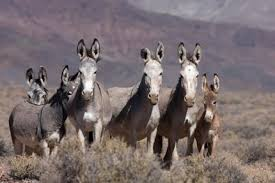 Mules, the Real Hawthorne Founders
Mules, the Real Hawthorne Founders
Founded in 1881 as a division point on the Carson & Colorado Railroad, Hawthorne's site was selected by the mules used by the work crews to grade the right-of-way. Turned loose to forage for themselves in the winter, they found the most sheltered spot on the valley to protect themselves from the freezing wind. The humans had the wisdom to accept their critters' advice, and Hawthorne was established in this favored location in the valley.
Genealogy Connections:
Hawthorne was home to Davis & Augustus (Golden), Benjamin, and Samuel H Rosenthal. Davis and Benjamin both owned and operated the Lakeview Hotel
Judge & Assemblyman W. J. Henley and his family (Henrietta Kate Rosenthal (wife), Benjamin, Lloyd, Willey, Davis and my grandmother, Clara Belle Henley (McGee). Lloyd Henley drowned in Walker Lake at age 14.
Both my brothers, Daniel C Barnett & David J Barnett, commuted from Yerington to Hawthorne to work at the Naval Ammunition Depot in the late 1960’s - early 1970’s. David Barnett opened a music store, The Music Corral, in Hawthorne in 2004. It failed in six months.
|
Hawthorne is the name of the town site at the present terminus of the Carson and Colorado Railroad, on the east shore of Walker's Lake. Hawthorne is located about in the middle of Mineral County on U.S. Highway 95 just north of the present U.S. Naval Ammunition Depot.
Hawthorne Timeline
Early 1800's
Spanish Miners
The Legend of the Bells (Mineral County Museum, Hawthorne, Nevada)
Spanish Miners traveled through the area in the early 1800's. In a glass case in a small historical museum in Hawthorne, Nevada are artifacts that may have been intended for a Nevada Mission that seems not to have been realized. The Legend of the Bells tells of a missionary seeking a site on which to found a mission. He was attacked and the bells were lost. These Mission Bells were found buried in the ground about 15 miles southeast of Hawthorne and may, or may not, be the mission bells
1827
| Jedediah Smith, first non-native explorer into Nevada, passed near Walker Lake in 1827 during his remarkable trip from west to east across the state. |
Jedediah Strong Smith (January 6, 1799 – May 27, 1831), the son of a Bainbridge, New York general store owner, was a hunter, trapper, fur trader, trailblazer, author, cartographer and explorer of the Rocky Mountains, the American West Coast and the Southwest during the 19th century. Nearly forgotten by historians almost a century after his death, Smith has been rediscovered as an American hero who was the first white man to travel overland from the Salt Lake frontier, the Colorado River, the Mojave Desert, and finally into California. Smith was the first United States citizen to explore and eastwardly cross the Sierra Nevada and the treacherous Great Basin. Smith also was the first American to travel up the California coast to reach the Oregon Country. Not only was he the first to do this, but he and Robert Stuart discovered the South Pass. This path became the main route used by pioneers to travel to the Oregon Country. Surviving three massacres and one bear mauling, Jedediah Smith's explorations and documented discoveries were highly significant in opening the American West to expansion by white settlers and cattlemen. In 1831, while searching for water off the Santa Fe Trail, Smith was mortally wounded by Commanche warriors.
1829
Peter Skene Ogden, another noted earlier explorer of the region now known as The Great Basin, was here in 1829, Peter Skene Ogden (alternately Skeene, Skein or Skeen), (baptised 12 February 1790 – September 27, 1854[1]) was a fur trader and a Canadian explorer of what is now British Columbia and the American West. During his many expeditions he explored parts of Oregon, Washington, Nevada, California, Utah, Idaho and Wyoming and despite early confrontations with the Hudson' Bay Company during his time with the North West Company, later became a senior official in the operations of the HBC's Columbia Department, serving as first Chief Trader of Fort Simpson and similar posts.
1845
John Charles Frémont or Fremont (January 21, 1813 – July 13, 1890) was an American military officer, explorer, and politician who became the first candidate of the anti-slavery Republican Party for the office of President of the United States. During the 1840s, when he led four expeditions into the American West, that era's penny press and admiring historians accorded Frémont the sobriquet The Pathfinder.
1860-1861
Hawthorne is part of what was once known as Esmeralda in the Nevada Territory. Actually you could say it were once part of Western Utah Territory, because gold was discovered at Aurora in 1860 one year before the Territory of Nevada was formed.


Most of Hawthorne’s written history starts in 1861, when the miners of all types began to arrive in Aurora looking to strike it rich. Aurora was such a rich area that both Nevada and California claimed it for their own. This lead to a great deal of confusion when Aurora was the County Seat of Mono County California and Esmeralda County Nevada Territory at the same time. But when the dust finally settled Aurora was found to be in Nevada and went on to be one of the wildest towns in the wild west.
1881
Mules, the Real Hawthorne Founders
Founded in 1881 as a division point on the Carson & Colorado Railroad, Hawthorne's site was selected by the mules used by the work crews to grade the right-of-way. Turned loose to forage for themselves in the winter, they found the most sheltered spot on the valley to protect themselves from the freezing wind. The humans had the wisdom to accept their critters' advice, and Hawthorne was established in this favored location in the valley.
Henry Marvin Yerington
(My relatives,The Rosenthals & Henley’s were contemporaries of Henry Yerington)
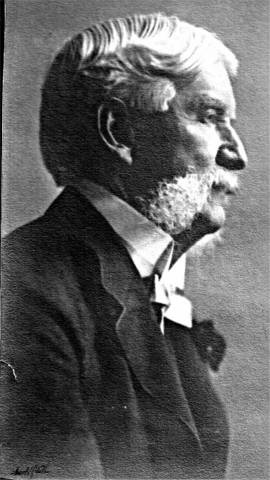
 H.M. Yerington (16 May 1829, Virginia - 3 Sep 1910 Carson City, Nevada) with wife, Susan, in right picture.
Henry Marvin Yerington was born in Canada in 1828 and came to Nevada in 1863. He was actively involved in mining, lumbering, railroads, and land development in Nevada and California until his death in 1910. He is reported to have been president of sixteen different companies at one time and actively involved in forty. Yerington was a leader in the Republican Party in Nevada and very influential in state politics. He is probably best known as the general superintendent and vice-president of the Virginia and Truckee Railroad and as a construction superintendent and president of the Carson and Colorado Railroad. The city of Yerington is named for Henry Marvin Yerington; prominent Nevada businessman and railroad builder. Their home was located at 512 North Division St. Carson City NV. Burial: Lone Mountain Cemetery , Carson City, Nevada
H.M. Yerington (16 May 1829, Virginia - 3 Sep 1910 Carson City, Nevada) with wife, Susan, in right picture.
Henry Marvin Yerington was born in Canada in 1828 and came to Nevada in 1863. He was actively involved in mining, lumbering, railroads, and land development in Nevada and California until his death in 1910. He is reported to have been president of sixteen different companies at one time and actively involved in forty. Yerington was a leader in the Republican Party in Nevada and very influential in state politics. He is probably best known as the general superintendent and vice-president of the Virginia and Truckee Railroad and as a construction superintendent and president of the Carson and Colorado Railroad. The city of Yerington is named for Henry Marvin Yerington; prominent Nevada businessman and railroad builder. Their home was located at 512 North Division St. Carson City NV. Burial: Lone Mountain Cemetery , Carson City, Nevada
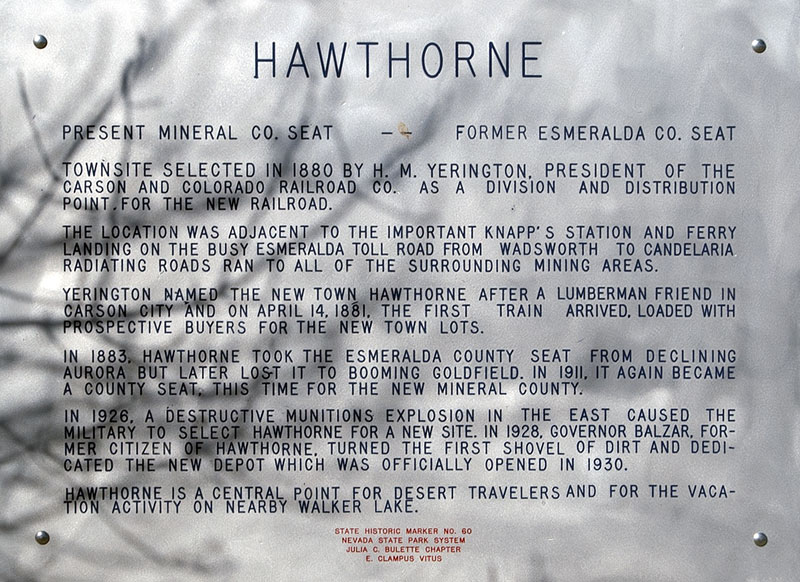
The townsite of Hawthorne was selected in 1880 by H.M. Yerington, the president of the Carson and Colorado Railroad Company. Named for a lumberman friend in Carson City, Hawthorne was located near the busy Esmeralda toll road running from Wadsworth to Candelaria, from which radiating roads ran to all of the surrounding mining areas. Thus, it was the perfect location to place a division and distribution point for Mr. Yerington's new railroad.

The location was adjacent to the important Knapp's Station and Ferry Landing on the busy Esmeralda toll road from Wadsworth to Candelaria. Radiating roads ran to all of the surrounding mining areas.

On April 14, 1881, the first train arrived, loaded with prospective buyers for the new town lots. As an interesting aside, the enterprising Mr. Yerington lent his name to another Nevada Town: Yerington, NV, an agricultural center located in Lyon County.
The Virginia Evening Chronicle of April 1, 1881
The new town of Hawthorne, on the line of the Carson and Colorado Railroad at Walker Lake, will, in the near future, give employment to a great many working men of all classes. The town at present consists of two tents and a clapboard shanty, but when the railroad begins to crawl out that way it will grow very rapidly.
Hawthorne will doubtless be the county seat of Esmeralda County in a year or two, and as it will be at the Junction of the railroad and the Bodie wagon road, it is sure to be a prosperous place.
The new wagon road to Bodie, which is owned by the same men who are building the Carson and Colorado Railroad, is as fine a grade as is to be found any place in the mountains. From Aurora to Bodie a new route has been taken, that, although two miles longer than the old one, is nearly an hour shorter in time. The old grade, which is still traveled by a few, is in places precipitous and dangerous. The new grade is so constructed that a railroad track could be laid down on it without much additional work. The railroad will not be built to Bodie, however. The people out there prefer to have the teams and teamsters.
Esmeralda County for the past ten years has had a steady and healthy growth. Her present population is 3,220; assessed property valuation, $1,179,388; and total debt, $32,9l5.
News Clippings about Early Hawthorne
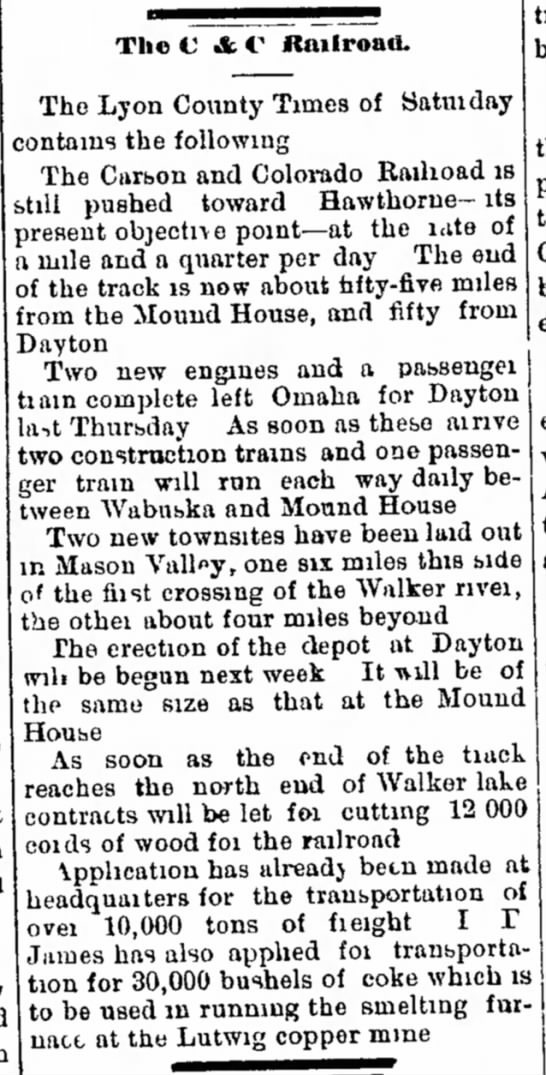
(My relatives,The Rosenthals & Henley’s were contemporaries of Henry Yerington)
H.M. Yerington (16 May 1829, Virginia - 3 Sep 1910 Carson City, Nevada) with wife, Susan, in right picture.
Henry Marvin Yerington was born in Canada in 1828 and came to Nevada in 1863. He was actively involved in mining, lumbering, railroads, and land development in Nevada and California until his death in 1910. He is reported to have been president of sixteen different companies at one time and actively involved in forty. Yerington was a leader in the Republican Party in Nevada and very influential in state politics. He is probably best known as the general superintendent and vice-president of the Virginia and Truckee Railroad and as a construction superintendent and president of the Carson and Colorado Railroad. The city of Yerington is named for Henry Marvin Yerington; prominent Nevada businessman and railroad builder. Their home was located at 512 North Division St. Carson City NV. Burial: Lone Mountain Cemetery , Carson City, Nevada
The townsite of Hawthorne was selected in 1880 by H.M. Yerington, the president of the Carson and Colorado Railroad Company. Named for a lumberman friend in Carson City, Hawthorne was located near the busy Esmeralda toll road running from Wadsworth to Candelaria, from which radiating roads ran to all of the surrounding mining areas. Thus, it was the perfect location to place a division and distribution point for Mr. Yerington's new railroad.
The location was adjacent to the important Knapp's Station and Ferry Landing on the busy Esmeralda toll road from Wadsworth to Candelaria. Radiating roads ran to all of the surrounding mining areas.
On April 14, 1881, the first train arrived, loaded with prospective buyers for the new town lots. As an interesting aside, the enterprising Mr. Yerington lent his name to another Nevada Town: Yerington, NV, an agricultural center located in Lyon County.
The Virginia Evening Chronicle of April 1, 1881
The new town of Hawthorne, on the line of the Carson and Colorado Railroad at Walker Lake, will, in the near future, give employment to a great many working men of all classes. The town at present consists of two tents and a clapboard shanty, but when the railroad begins to crawl out that way it will grow very rapidly.
Hawthorne will doubtless be the county seat of Esmeralda County in a year or two, and as it will be at the Junction of the railroad and the Bodie wagon road, it is sure to be a prosperous place.
The new wagon road to Bodie, which is owned by the same men who are building the Carson and Colorado Railroad, is as fine a grade as is to be found any place in the mountains. From Aurora to Bodie a new route has been taken, that, although two miles longer than the old one, is nearly an hour shorter in time. The old grade, which is still traveled by a few, is in places precipitous and dangerous. The new grade is so constructed that a railroad track could be laid down on it without much additional work. The railroad will not be built to Bodie, however. The people out there prefer to have the teams and teamsters.
Esmeralda County for the past ten years has had a steady and healthy growth. Her present population is 3,220; assessed property valuation, $1,179,388; and total debt, $32,9l5.
|
News Clippings about Early Hawthorne
Nevada State Journal, 2 February 1881
Nevada State Journal, 6 March 1881
Nevada State Journal, 26 March 1881
Nevada State Journal, 13 April 1881

The Lake View Hotel (House)
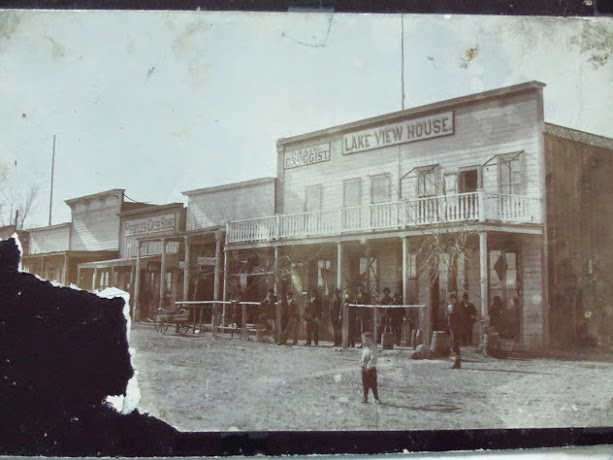
From their youth Benjamin & Samuel Rosenthal were connected with the hotel business, assisting his father & mother, Davis & Augusta Rosenthal, in the conduct of the Lake View Hotel, of which Benjamin later became the proprietor. They had the faculty of making their guests feel at home, and did everything in thier power for their comfort. The hotel is fifty by ninety feet, two stories in height and contains twenty-five sleeping apartments. It is an excellent hotel for a town of the size of Hawthorne, and Mr. Rosenthal did a good business. He sets a good table, and his efforts to make his hostelry an attractive place of entertainment have resulted in winning him prosperity.
1883
In 1883, Hawthorne took the Esmeralda county seat from declining Aurora but later lost it to booming Goldfield. In 1911, it again became a county seat, this time for the new Mineral County.
 Mineral County Courthouse in Hawthorne, Nevada (National Register #82003214)
Mineral County Courthouse in Hawthorne, Nevada (National Register #82003214)
 I believe this picture of my grandfather William J Henley, judge, may have been taken in front of this courthouse, (front row 2nd from left)
I believe this picture of my grandfather William J Henley, judge, may have been taken in front of this courthouse, (front row 2nd from left)
Old County Courthouse

On July 1, 1883 the county seat of Esmeralda County moved from Aurora to Hawthorne. A courthouse was needed, so a contract to build it for $29125 was awarded. On August 16, 1883 construction began. Corruption and collusion between the contractor George W. Babcock, and political officials are revealed by a Grand Jury. In 1883, Hawthorne took the Esmeralda county seat from declining Aurora but later lost it to booming Goldfield. Despite the wrongdoings, in February of 1884 the building was opened and continued as a county entity until May 1907, when the county seat moved to Goldfield. In 1911, it again became a county seat, this time for the new Mineral County.
1888
The Lake View Hotel (House)
From their youth Benjamin & Samuel Rosenthal were connected with the hotel business, assisting his father & mother, Davis & Augusta Rosenthal, in the conduct of the Lake View Hotel, of which Benjamin later became the proprietor. They had the faculty of making their guests feel at home, and did everything in thier power for their comfort. The hotel is fifty by ninety feet, two stories in height and contains twenty-five sleeping apartments. It is an excellent hotel for a town of the size of Hawthorne, and Mr. Rosenthal did a good business. He sets a good table, and his efforts to make his hostelry an attractive place of entertainment have resulted in winning him prosperity.
1883
In 1883, Hawthorne took the Esmeralda county seat from declining Aurora but later lost it to booming Goldfield. In 1911, it again became a county seat, this time for the new Mineral County.
Mineral County Courthouse in Hawthorne, Nevada (National Register #82003214)
I believe this picture of my grandfather William J Henley, judge, may have been taken in front of this courthouse, (front row 2nd from left)
Old County Courthouse
On July 1, 1883 the county seat of Esmeralda County moved from Aurora to Hawthorne. A courthouse was needed, so a contract to build it for $29125 was awarded. On August 16, 1883 construction began. Corruption and collusion between the contractor George W. Babcock, and political officials are revealed by a Grand Jury. In 1883, Hawthorne took the Esmeralda county seat from declining Aurora but later lost it to booming Goldfield. Despite the wrongdoings, in February of 1884 the building was opened and continued as a county entity until May 1907, when the county seat moved to Goldfield. In 1911, it again became a county seat, this time for the new Mineral County.
1888
 Samuel H Rosenthal started a newspaper in Hawthorne in 1886-1888(??) before moving to Carson City to take a position in the state printing office in 1889.
Samuel H Rosenthal started a newspaper in Hawthorne in 1886-1888(??) before moving to Carson City to take a position in the state printing office in 1889.
1904
Mamie Frances Mingle
(1860, Port Huron, St. Clair County, Michigan - Mar. 4, 1948, Hawthorne, Mineral County, Nevada)
The story of Hawthorne is more the story of Mamie Frances Mingle, a native of Michigan who came to Nevada about 1904. She opened a boarding house in Goldfield then one in Diamondfield a year later and ultimately one in Aurora.

Jackson Lee "Diamondfield Jack" Davis (1864–1949) was pardoned for the 1896 Deep Creek Murders in Idaho and would later strike it rich in Nevada, where he established several mining towns, one named after his nickname "Diamondfield"
Diamondfield Jack in Nevada, circa 1904.
The Lucky Boy mine was discovered in 1908, five miles south of Hawthorne, and Mamie became the manager of the company boarding house and an important influence in the mine's early development. Weighing ninety pounds at the time and only 4 feet 10 inches tall, she acted as bouncer when boarding house miners get out of hand.
When Lucky Boy activity faded, Mamie refurbished her homestead near Walker Lake, raising chickens and selling poultry and eggs. Her favorite diversion was spending hours each Saturday fixing a chicken dinner for the children of Hawthorne, who were regaled by stories of mining camps and homespun advice. Mamie Mingle had known good and bad times in the heyday of the Nevada mining camps, had personified the indomitable spirit of the early pioneer women, and died peacefully at 88 in her home amid one of the largest industrial complexes in Nevada. Burial: Hawthorne Cemetery, Hawthorne, Mineral County, Nevada,Plot: Plot 8, row 3, grave 27
1907
Samuel H Rosenthal started a newspaper in Hawthorne in 1886-1888(??) before moving to Carson City to take a position in the state printing office in 1889.
1904
Mamie Frances Mingle
(1860, Port Huron, St. Clair County, Michigan - Mar. 4, 1948, Hawthorne, Mineral County, Nevada)
The story of Hawthorne is more the story of Mamie Frances Mingle, a native of Michigan who came to Nevada about 1904. She opened a boarding house in Goldfield then one in Diamondfield a year later and ultimately one in Aurora.
Jackson Lee "Diamondfield Jack" Davis (1864–1949) was pardoned for the 1896 Deep Creek Murders in Idaho and would later strike it rich in Nevada, where he established several mining towns, one named after his nickname "Diamondfield"
Diamondfield Jack in Nevada, circa 1904.
The Lucky Boy mine was discovered in 1908, five miles south of Hawthorne, and Mamie became the manager of the company boarding house and an important influence in the mine's early development. Weighing ninety pounds at the time and only 4 feet 10 inches tall, she acted as bouncer when boarding house miners get out of hand.
When Lucky Boy activity faded, Mamie refurbished her homestead near Walker Lake, raising chickens and selling poultry and eggs. Her favorite diversion was spending hours each Saturday fixing a chicken dinner for the children of Hawthorne, who were regaled by stories of mining camps and homespun advice. Mamie Mingle had known good and bad times in the heyday of the Nevada mining camps, had personified the indomitable spirit of the early pioneer women, and died peacefully at 88 in her home amid one of the largest industrial complexes in Nevada. Burial: Hawthorne Cemetery, Hawthorne, Mineral County, Nevada,Plot: Plot 8, row 3, grave 27
1907
Nevada State Journal, 13 May 1905 My grandfather ill.
1911
On February 11, 1911, Esmeralda County was split and Mineral County was created. Again, it became the center of county business until 1973, when a modern facility replaced it.
1926

Established after an explosion destroyed the Lake Denmark, New Jersey ammunition plant in 1926 and hundreds of people were injured in nearby towns. A court of inquiry investigating the explosion recommended that a depot be established in a remote area within 1,000 miles of the west coast to serve the Pacific area. The destructive munition explosion in the east caused the military to select Hawthorne for a new munitions storage site. It was Governor Balzar, a former citizen of Hawthorne, who in 1928 turned the first shovel of dirt and dedicated the new munition depot, which was officially opened in 1930. To this day, the U.S. Army Ammunition Depot, the world's largest facility of its kind, is the focal point of economic survival in Hawthorne, employing some 600 of the town's 4900 or so total inhabitants and injecting over $22 million into the local economy annually.
1930’s-1950’s
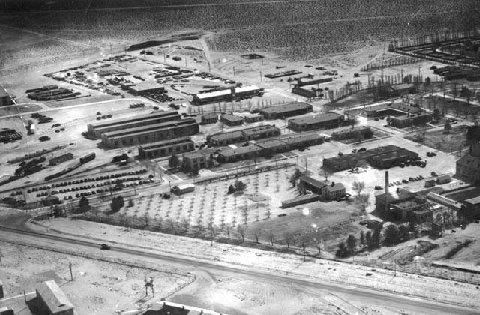 Hawthorne Naval Ammunition Depot (date is unknown)
Hawthorne Naval Ammunition Depot (date is unknown)
When approaching Hawthorne from the North on Highway 95, along beautiful Walker Lake, a major tourist destination, the first thing the traveler will notice is the myriad underground ammunition bunkers marching like soldiers across the valley in which Hawthorne sits.
 Officer's Quarters ca late 1930's-early 1940's
Photo courtesy of Virginia Usnick
Officer's Quarters ca late 1930's-early 1940's
Photo courtesy of Virginia Usnick
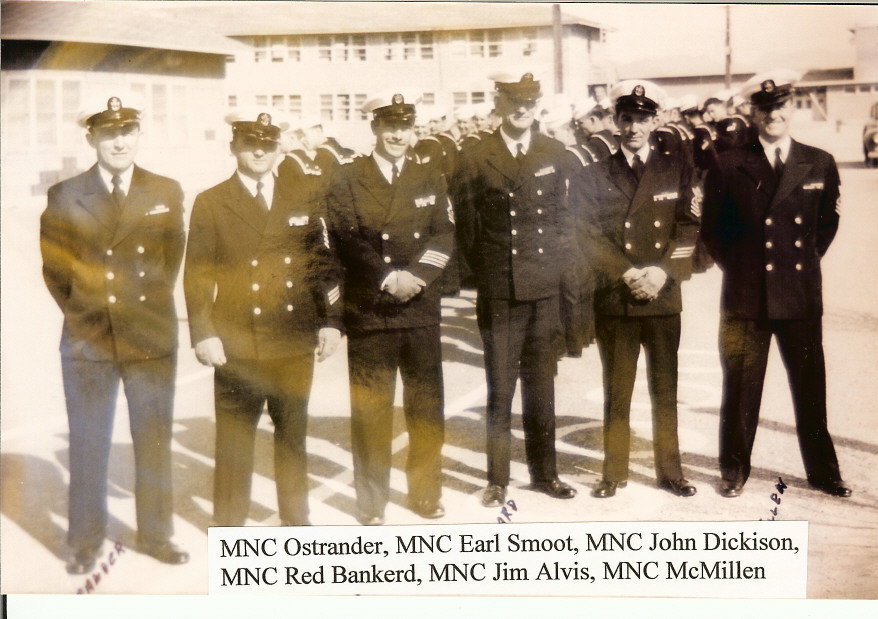 I went to school in Yerington with a George Ostrander. MNC Ostrander may have been his father or other relative.
I went to school in Yerington with a George Ostrander. MNC Ostrander may have been his father or other relative.
 Row upon row of storage buildings, which add up to more than two million square feet of space, make up the majority of the Hawthorne Army Ammunition Plant's 250 square miles of land, upon which NUWES' Detachment is a tenant. These particular buildings, which are maintained by NUWES, are framed by Nevada's Wassuc Mountains.
Row upon row of storage buildings, which add up to more than two million square feet of space, make up the majority of the Hawthorne Army Ammunition Plant's 250 square miles of land, upon which NUWES' Detachment is a tenant. These particular buildings, which are maintained by NUWES, are framed by Nevada's Wassuc Mountains.
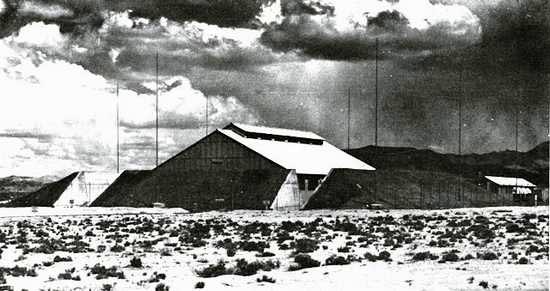 U.S. Navy archives This was the mine assembly building at the Navy Ammunition Depot (now Hawthorne Army Depot)
U.S. Navy archives This was the mine assembly building at the Navy Ammunition Depot (now Hawthorne Army Depot)
 Mk 16 mines are also worked on in Mine Assembly Building 104-6
1960-1970
Mk 16 mines are also worked on in Mine Assembly Building 104-6
1960-1970
 Hawthorne Army Depot Munitions Bunkers, Hawthorne, Nevada
Hawthorne Army Depot Munitions Bunkers, Hawthorne, Nevada
1980’s
True to its name, Mineral County is rich in mineral resources. During the Nevada mining boom of the 1980's, historical gold and silver mining areas such as Candelaria, Aurora, Santa Fe, and Rawhide saw renewed activity. These workings were and continue to be a source of much-needed cash for this small Nevada town.
1991
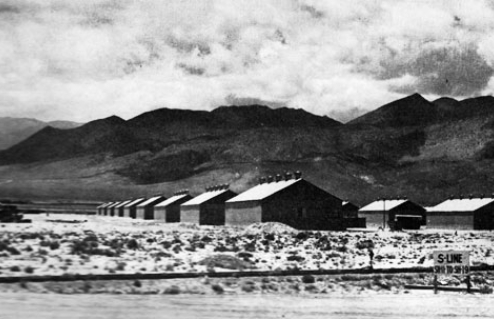
At the beginning of the Gulf War in 1991, Hawthorne saw the huge 16-inch gun barrels stored at its ammunition depot resurrected for service on the World War II-era battleships patrolling the Persian Gulf.

The Hawthorne Army Depot is in Mineral County and occupies approximately 150,000 acres of semiarid land surrounding the Hawthorne community. Hawthorne Army Depot is a government-owned, contractor-operated military industrial installation.

Presently, Hawthorne is a central point for desert travelers and for the vacation, sporting, and recreational activities on nearby Walker Lake.
Walker Lake

Walker Lake is a familiar sight to travelers on Highway 95 between Reno and Las Vegas. Its blue desert waters start on the east slopes of the Sierra Nevada in California, flow through farming communities at Bridgeport and Antelope Valley and then through Smith and Mason Valleys in Nevada. From Wabuska, the joined East and West Forks flow through the Walker River Paiute Reservation and then into Walker Lake, just north of Hawthorne, Nevada. The best-kept secret of Walker Lake is that it is one of only six freshwater terminal lakes in the world.
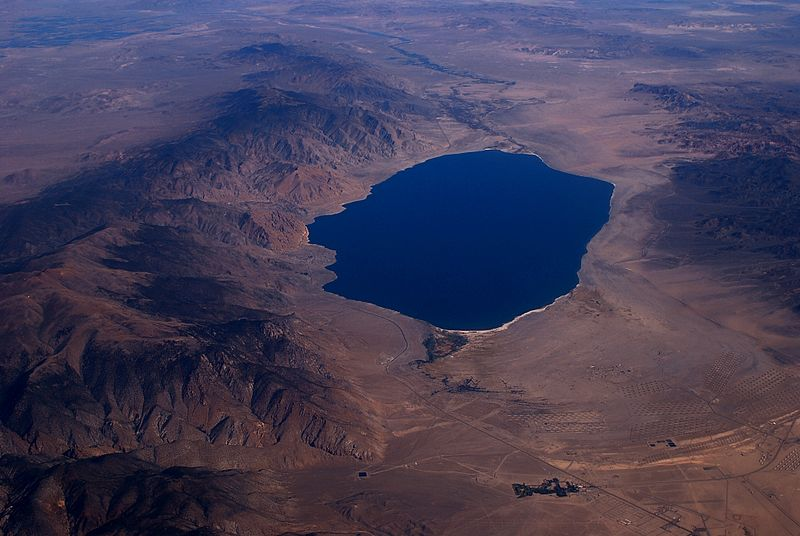 Aerial view of Walker Lake
Aerial view of Walker Lake
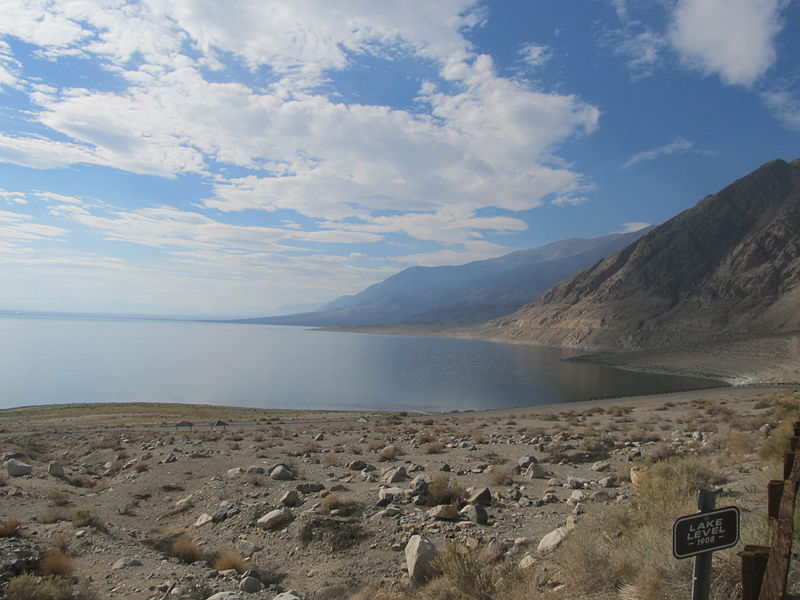 Walker Lake, Nevada with sign in lower-right showing lake elevation in 1908.
Walker Lake, Nevada with sign in lower-right showing lake elevation in 1908.
 Sportsmen's Beach, Walker Lake, Nevada
Sportsmen's Beach, Walker Lake, Nevada


Walker Lake is famous for its Lathontan cutthroat trout fishery. Recently, the original strain of lake cutthroats, believed to be extinct, was found surviving in a small creek in northeastern Nevada. These trout which grew to over 40 pounds were re-introduced to Walker Lake in hopes that they will regain their great size. Less well-known is its support of thousands of migratory waterfowl and shorebirds, including biannual visits of up to 1400 common loons. Walker Lake recreational uses are the mainstay of the economy of small rural Mineral County.
Town of Hawthorne
Although a shadow of its former self, Hawthorne clings to life with the typical Nevada fervor, its residents always ready with a welcoming smile and intriguing stories for all who will stop and sit a spell.
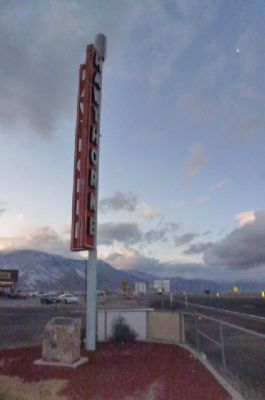 The Unlit Pillar of Light Marker
The Unlit Pillar of Light Marker


If you've ever made the trek between Reno and Las Vegas, you've likely driven right by the front door. The El Capitan Hotel and Casino has proudly done business along Highway 95 in Hawthorne since the 1930's, with it's heyday coming during the area's boom in World War II when thousands of soldiers were either stationed here or tripped through the town on their way to defending our country.
 1930’s
1930’s
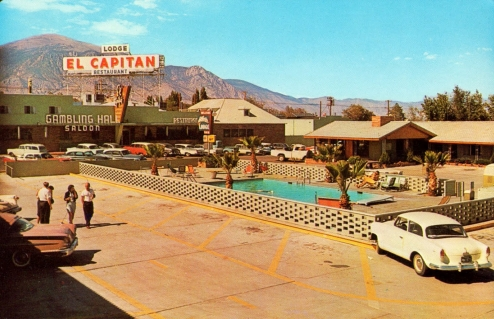 1950’s
1950’s
But, like many famous locations in the Silver State, the El Cap has plenty of stories to tell. Some may be more folklore than others. One of the more unique features about the El Capitan in Hawthorne is something that you can't even see: it's underground. Legend says that, back in the 1940s, there was a tunnel that linked the El Capitan to the Monte Carlo across the street. It's been shut down for decades.
So what did they transport between the two casinos? How about booze and women.
Another story says the El Cap burned down in 1942 as a result of a brawl between some Marines and a group of locals. That tale says the El Cap was quickly rebuilt, and it's classic 1960s Nevada casino facade continues until this day. Despite the boom and bust that the hardy people of this tight knit community have gone through over the years, the El Cap has endured with them.

Walker River Paiute Tribe

While most people think of 1861 as the start of Hawthorne’s local history it is far from the being. What is now called Walker Lake, just outside of Hawthorne, Nevada, has long been the home of the "Agai Ducutta Numa" members of the Paiute tribe whose name means “Trout Eater People.”
 Paiute family and wikiup in 1906.
Paiute family and wikiup in 1906.
Mineral County is also home to the Walker River Paiute Indian Reservation, which occupies over 200,000 acres and is located in the northwestern portion of Mineral County, spilling over to the north into Churchill County and to the west into Lyon County.
The reservation's land area is 529.970 square miles (1,372.616 km²) and a population of 853 persons was reported at the 2000 census. Schurz is the only town on the reservation. Weber Reservoir, an impoundment of the Walker River, is located upstream of Schurz and provides irrigation water for farms on the reservation. Most of the reservation is cattle range. The reservation belongs to the Walker River Paiute Tribe, a Northern Paiute tribe. Their Paiute name is Agai-Ticutta. The English translation means "Trout Eaters."

The Walker River Indian Reservation is an Indian reservation located in central Nevada in the United States. It is located along the Walker River between Yerington and Walker Lake. At the current lake level, the reservation has only a small frontage on Walker Lake. The bulk of the reservation (72.68%) is in Mineral County; however portions are in Lyon County (14.37%) and Churchill County(12.95%).
 The reservation's land area is 529.970 square miles (1,372.616 km²) and a population of 853 persons was reported at the 2000 census. Schurz is the only town on the reservation. Weber Reservoir, an impoundment of the Walker River, is located upstream of Schurz and provides irrigation water for farms on the reservation. Most of the reservation is cattle range.
The reservation's land area is 529.970 square miles (1,372.616 km²) and a population of 853 persons was reported at the 2000 census. Schurz is the only town on the reservation. Weber Reservoir, an impoundment of the Walker River, is located upstream of Schurz and provides irrigation water for farms on the reservation. Most of the reservation is cattle range.
The reservation belongs to the Walker River Paiute Tribe, a federally recognized tribe of Northern Paiute people. Their Paiute name is Agai-Ticutta. The English translation means "Trout Eaters."

Popular Paiute songs are associated with hand games, Round Dances, and doctor's curing. Variations on the Round, or Circle, Dance were traditionally the most common dance form and the oldest. The Northern Paiute Hump Dance represented one variation. In a Round Dance, the participants form a circle and dance around often in a clockwise direction to music made by a singer situated in the center. A Round Dance is commonly held three times a year, during the Spring fishing season, just before fall pine-nut harvest, and during the November rabbit drives. Such dances serve to periodically affirm social unity and focus participants on the particular subsistence tasks at hand.
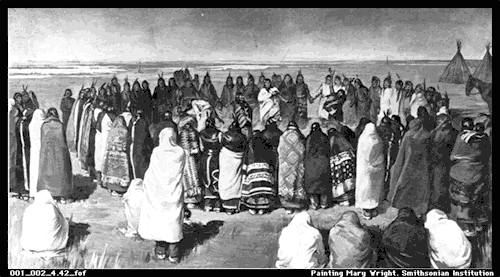

In 1889 Wovoka, a Southern Paiute, founded the Ghost Dance religion. In a vision, he saw the earth reborn in a natural state and returned to the Indians and their ancestors, free from white man's control. Wovoka taught his followers that they could achieve this vision by dancing, chanting, and eliminating all traces of white influence from their lives. The Ghost Dance incorporated the earlier Round Dance elements, including the lack of a percussion accompaniment. Wovoka, creator of the Ghost Dance, is buried in Schurz.
Paiute Crafts & Jewelry
The Paiute People of the Great Basin are known for their basketry. Many of these Paiute Indian baskets served utilitarian purposes. Paiute Indian basketry forms include Paiute cradleboards, Paiute water jars,Paiute Burden Baskets, Paiute Basketry Canteens, Paiute Seed Jars, Paiute Beaded Baskets, Paiute Winnowing Trays, Paiute Ollas. Paiute Native American Indian Basket weavers known for their great skill include Carrie Bethel, and Lucy Tells.
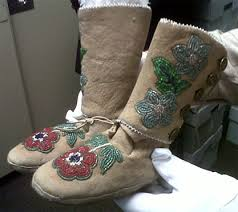








 Paiute necklace 1910
Paiute necklace 1910
Schurz, Nevada
 Walker River Reservation, Methodist Episcopal Church, Schurz, Nevada, June 21, 1920
Walker River Reservation, Methodist Episcopal Church, Schurz, Nevada, June 21, 1920

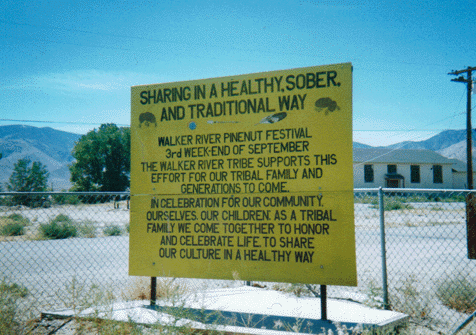 Every year on the 3rd weekend of September is the Pinenut Festival at Schurz Nevada. Sponsored by the Walker River Paiute Tribe. This is a weekend of fun. They have a Festival and Indian rodeo and many other events over the weekend.
Every year on the 3rd weekend of September is the Pinenut Festival at Schurz Nevada. Sponsored by the Walker River Paiute Tribe. This is a weekend of fun. They have a Festival and Indian rodeo and many other events over the weekend.

Shoe Tree
It's a dead tree with shoes thrown into it, yes, but the real story behind it is why the shoes are there:
When I was a boy there were a lot more branches and a boat-load more shoes. People have been throwing shoes in that tree since my dad was little and he's 53 now. The reason you are supposed to throw your shoes into that tree is kinda a rite of passage, or more bluntly put, you lost your virginity. Located in between Schurz and Walker Lake Nevada
Sources:
Nevada Division of Water Planning, http://www.state.nv.us
Mineral County Economic Development Partnership, P.O. Box 1635, Hawthorne, NV 89415 Submitted by Jerry Lorengo
The History of the State of Nevada, 1881 submitted by Cathy Danielson
Nevada State Journal
1911
On February 11, 1911, Esmeralda County was split and Mineral County was created. Again, it became the center of county business until 1973, when a modern facility replaced it.
1926
Established after an explosion destroyed the Lake Denmark, New Jersey ammunition plant in 1926 and hundreds of people were injured in nearby towns. A court of inquiry investigating the explosion recommended that a depot be established in a remote area within 1,000 miles of the west coast to serve the Pacific area. The destructive munition explosion in the east caused the military to select Hawthorne for a new munitions storage site. It was Governor Balzar, a former citizen of Hawthorne, who in 1928 turned the first shovel of dirt and dedicated the new munition depot, which was officially opened in 1930. To this day, the U.S. Army Ammunition Depot, the world's largest facility of its kind, is the focal point of economic survival in Hawthorne, employing some 600 of the town's 4900 or so total inhabitants and injecting over $22 million into the local economy annually.
1930’s-1950’s
Hawthorne Naval Ammunition Depot (date is unknown)
When approaching Hawthorne from the North on Highway 95, along beautiful Walker Lake, a major tourist destination, the first thing the traveler will notice is the myriad underground ammunition bunkers marching like soldiers across the valley in which Hawthorne sits.
Officer's Quarters ca late 1930's-early 1940's
Photo courtesy of Virginia Usnick
I went to school in Yerington with a George Ostrander. MNC Ostrander may have been his father or other relative.
Row upon row of storage buildings, which add up to more than two million square feet of space, make up the majority of the Hawthorne Army Ammunition Plant's 250 square miles of land, upon which NUWES' Detachment is a tenant. These particular buildings, which are maintained by NUWES, are framed by Nevada's Wassuc Mountains.
U.S. Navy archives This was the mine assembly building at the Navy Ammunition Depot (now Hawthorne Army Depot)
Mk 16 mines are also worked on in Mine Assembly Building 104-6
1960-1970
Hawthorne Army Depot Munitions Bunkers, Hawthorne, Nevada
1980’s
True to its name, Mineral County is rich in mineral resources. During the Nevada mining boom of the 1980's, historical gold and silver mining areas such as Candelaria, Aurora, Santa Fe, and Rawhide saw renewed activity. These workings were and continue to be a source of much-needed cash for this small Nevada town.
1991
At the beginning of the Gulf War in 1991, Hawthorne saw the huge 16-inch gun barrels stored at its ammunition depot resurrected for service on the World War II-era battleships patrolling the Persian Gulf.
The Hawthorne Army Depot is in Mineral County and occupies approximately 150,000 acres of semiarid land surrounding the Hawthorne community. Hawthorne Army Depot is a government-owned, contractor-operated military industrial installation.
Presently, Hawthorne is a central point for desert travelers and for the vacation, sporting, and recreational activities on nearby Walker Lake.
Walker Lake
Walker Lake is a familiar sight to travelers on Highway 95 between Reno and Las Vegas. Its blue desert waters start on the east slopes of the Sierra Nevada in California, flow through farming communities at Bridgeport and Antelope Valley and then through Smith and Mason Valleys in Nevada. From Wabuska, the joined East and West Forks flow through the Walker River Paiute Reservation and then into Walker Lake, just north of Hawthorne, Nevada. The best-kept secret of Walker Lake is that it is one of only six freshwater terminal lakes in the world.
Aerial view of Walker Lake
Walker Lake, Nevada with sign in lower-right showing lake elevation in 1908.
Sportsmen's Beach, Walker Lake, Nevada
Walker Lake is famous for its Lathontan cutthroat trout fishery. Recently, the original strain of lake cutthroats, believed to be extinct, was found surviving in a small creek in northeastern Nevada. These trout which grew to over 40 pounds were re-introduced to Walker Lake in hopes that they will regain their great size. Less well-known is its support of thousands of migratory waterfowl and shorebirds, including biannual visits of up to 1400 common loons. Walker Lake recreational uses are the mainstay of the economy of small rural Mineral County.
Town of Hawthorne
Although a shadow of its former self, Hawthorne clings to life with the typical Nevada fervor, its residents always ready with a welcoming smile and intriguing stories for all who will stop and sit a spell.
The Unlit Pillar of Light Marker
If you've ever made the trek between Reno and Las Vegas, you've likely driven right by the front door. The El Capitan Hotel and Casino has proudly done business along Highway 95 in Hawthorne since the 1930's, with it's heyday coming during the area's boom in World War II when thousands of soldiers were either stationed here or tripped through the town on their way to defending our country.
1930’s
1950’s
But, like many famous locations in the Silver State, the El Cap has plenty of stories to tell. Some may be more folklore than others. One of the more unique features about the El Capitan in Hawthorne is something that you can't even see: it's underground. Legend says that, back in the 1940s, there was a tunnel that linked the El Capitan to the Monte Carlo across the street. It's been shut down for decades.
So what did they transport between the two casinos? How about booze and women.
Another story says the El Cap burned down in 1942 as a result of a brawl between some Marines and a group of locals. That tale says the El Cap was quickly rebuilt, and it's classic 1960s Nevada casino facade continues until this day. Despite the boom and bust that the hardy people of this tight knit community have gone through over the years, the El Cap has endured with them.
Walker River Paiute Tribe
While most people think of 1861 as the start of Hawthorne’s local history it is far from the being. What is now called Walker Lake, just outside of Hawthorne, Nevada, has long been the home of the "Agai Ducutta Numa" members of the Paiute tribe whose name means “Trout Eater People.”
Paiute family and wikiup in 1906.
Mineral County is also home to the Walker River Paiute Indian Reservation, which occupies over 200,000 acres and is located in the northwestern portion of Mineral County, spilling over to the north into Churchill County and to the west into Lyon County.
The reservation's land area is 529.970 square miles (1,372.616 km²) and a population of 853 persons was reported at the 2000 census. Schurz is the only town on the reservation. Weber Reservoir, an impoundment of the Walker River, is located upstream of Schurz and provides irrigation water for farms on the reservation. Most of the reservation is cattle range. The reservation belongs to the Walker River Paiute Tribe, a Northern Paiute tribe. Their Paiute name is Agai-Ticutta. The English translation means "Trout Eaters."
The Walker River Indian Reservation is an Indian reservation located in central Nevada in the United States. It is located along the Walker River between Yerington and Walker Lake. At the current lake level, the reservation has only a small frontage on Walker Lake. The bulk of the reservation (72.68%) is in Mineral County; however portions are in Lyon County (14.37%) and Churchill County(12.95%).
The reservation belongs to the Walker River Paiute Tribe, a federally recognized tribe of Northern Paiute people. Their Paiute name is Agai-Ticutta. The English translation means "Trout Eaters."
Popular Paiute songs are associated with hand games, Round Dances, and doctor's curing. Variations on the Round, or Circle, Dance were traditionally the most common dance form and the oldest. The Northern Paiute Hump Dance represented one variation. In a Round Dance, the participants form a circle and dance around often in a clockwise direction to music made by a singer situated in the center. A Round Dance is commonly held three times a year, during the Spring fishing season, just before fall pine-nut harvest, and during the November rabbit drives. Such dances serve to periodically affirm social unity and focus participants on the particular subsistence tasks at hand.
In 1889 Wovoka, a Southern Paiute, founded the Ghost Dance religion. In a vision, he saw the earth reborn in a natural state and returned to the Indians and their ancestors, free from white man's control. Wovoka taught his followers that they could achieve this vision by dancing, chanting, and eliminating all traces of white influence from their lives. The Ghost Dance incorporated the earlier Round Dance elements, including the lack of a percussion accompaniment. Wovoka, creator of the Ghost Dance, is buried in Schurz.
Paiute Crafts & Jewelry
The Paiute People of the Great Basin are known for their basketry. Many of these Paiute Indian baskets served utilitarian purposes. Paiute Indian basketry forms include Paiute cradleboards, Paiute water jars,Paiute Burden Baskets, Paiute Basketry Canteens, Paiute Seed Jars, Paiute Beaded Baskets, Paiute Winnowing Trays, Paiute Ollas. Paiute Native American Indian Basket weavers known for their great skill include Carrie Bethel, and Lucy Tells.
Paiute necklace 1910
Schurz, Nevada
Walker River Reservation, Methodist Episcopal Church, Schurz, Nevada, June 21, 1920
Every year on the 3rd weekend of September is the Pinenut Festival at Schurz Nevada. Sponsored by the Walker River Paiute Tribe. This is a weekend of fun. They have a Festival and Indian rodeo and many other events over the weekend.
Shoe Tree
It's a dead tree with shoes thrown into it, yes, but the real story behind it is why the shoes are there:
When I was a boy there were a lot more branches and a boat-load more shoes. People have been throwing shoes in that tree since my dad was little and he's 53 now. The reason you are supposed to throw your shoes into that tree is kinda a rite of passage, or more bluntly put, you lost your virginity. Located in between Schurz and Walker Lake Nevada
Sources:
Nevada Division of Water Planning, http://www.state.nv.us
Mineral County Economic Development Partnership, P.O. Box 1635, Hawthorne, NV 89415 Submitted by Jerry Lorengo
The History of the State of Nevada, 1881 submitted by Cathy Danielson
Nevada State Journal
Monday, August 25, 2014
Yerington & Tonopah Pioneer Dairies
Yerington & Tonopah Pioneer Dairies
Family Stories: Charles Barton McGee and Clara Belle Henley (McGee)
Milk bottles from the Yerington Dairy in Mason Valley, NV. This Dairy was owned by my grandfather, Charles Barton McGee until his death in 1936.
One of my grandparents dairy cows, “Bessie”
Learning early, a young John “Jack” Barton McGee, son of Bart McGee preparing to milk. (Tonopah 1926)
Tonopah Pioneer Dairy Bottle Collection NV - Tonopah, Nye County - 1910-1920 Square or etched bottles are considered rare, while the round or embossed bottles are common [Ref : Nevada History Through Glass, Vol 1, Fred Holabird, 2012,p. 266].
One pint from John DuPratt’s Pioneer Dairy. Slug plate reads “Pioneer Dairy Trade Mark, Tonopah, Nevada.” Little wear, has a beautiful purple color. 2) One pint 3) One quart from the George McKenna and Bart McGee’s Pioneer Dairy. Pioneer Dairy went through several merges in its history. According to Fred Holabird “these are some of the prettiest of all Nevada milk bottles” [Ref: Nevada History Through Glass, Vol I, Fred Holabird, 2012]
Two gorgeous milk bottles from the Pioneer Dairy of Tonopah. George McKenna and Bart McGee owned and operated the Pioneer Dairy until they sold to the Serventi brothers in 1910. These two rare milk bottles are among the finest known Nevada milk bottles. 1) A 9.5” tall, ribbed “One Quart” bottle. The slug is embossed “Pioneer Dairy/ McG & McK/ Tonopah Nevada” and the bottom is embossed “DeLaval”. Clear glass, very faint purple hue developing, one small chip in bottom. Several small bubbles throughout body. Beautifully clean. 2) A 5.5” tall, ribbed “Half Pint” bottle. The slug is embossed Pioneer Dairy/ McG & McK/ Tonopah Nevada” and the bottom is embossed “DeLaval”. Clear glass with bold purple color developing. No chips or bubbles. Pristine. - Jacobitz Collection -59801
No comments:
Post a Comment